Field





Field







Agriculture has always been a cyclical industry, so although things are looking good at present, they may not be quite so rosy in the future, thanks to the challenges the sector faces. P6 so gricultur ay try


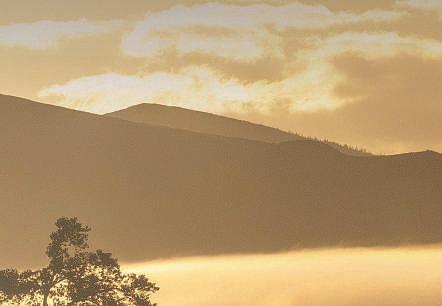





























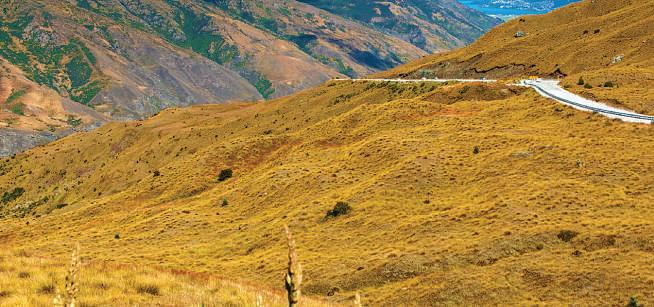







Chris Tobin
Farmers will be able to bypass brokers and merchants, sending their wool directly to processor WoolWorks as part of a new route to market.
WoolWorks has launched WoolWorks Grower Direct in which growers can send their wool straight to WoolWorks in Timaru.
The company is the world’s largest wool processor, with plants in Timaru, as well as Awatoto and Clive near Napier. The company processed about 100 million greasy kilograms of wool, or 80% of New Zealand’s wool clip.
“We’re using technology to make things more efficient and to save farmers money,” WoolWorks Grower Direct general manager Jason Everson said. “We’re putting a few more dollars into farmers’ pockets.”
The company has also started weekly online auctions supported by all major buyers of New Zealand wool, many of them longstanding wool scouring customers of the company.
Everson said the online auction bypassed the traditional route to market of “open cry auctions,” currently held once a fortnight in the South Island (alternating with the North Island the other week) in which buyers had to be physically present.
“We’re connecting directly with growers to create efficiencies and shorten the supply chain,” Everson said.
“Buying wool from WoolWorks’ Timaru store has commercial benefits to buyers as they do not have to factor freight costs into their pricing to get the wool to WoolWorks for scouring, and they can get the wool scoured and shipped a lot quicker.
“Due to the frequency of the sales, growers can get paid more quickly.”
Everson said the new system had been working well since it started just before Christmas and would be rolled out in the North Island in the next couple of months.
“It has been set up from scratch and

we’re taking a very measured approach, making sure we’ve got all aspects of the brokering side working as it should.”
New Zealand’s leading wool broker and handler, PGG Wrightson, declined to comment on the move by WoolWorks.
WoolWorks Grower Direct operation manager Breanna Hayes said the wool industry was “ripe” for change.
“We’ve set up a low-cost model to help improve farmer returns. We currently have limited influence over wool markets, but we can control the cost to get wool to the market,” Hayes said
“It’s about improving efficiencies.”
Southland sheep and beef farmer Allan Marshall said direct supply cut costs out of the system.
“Most of New Zealand’s wool is scoured locally before export, it makes sense to sell it through the scouring plant.”
Meat processor Silver Fern Farms recently acquired a 12.5% shareholding in WoolWorks. “They want to help their sheep and beef shareholders,” Everson said. “A lot of our clients are Alliance clients; you don’t have to be Silver Fern Farms.”

There
Top

A
Two
Sonita Chandar EDITOR
It’s no secret that farmers have been finding things down on the farm incredibly tough for the past few years. Inflation, lower commodity prices, and rising costs – including high interest rates – have hit them in the pocket
But it appears that the tide is turning with commodity prices bouncing back, higher production and a lower New Zealand dollar all replenishing the coffers and wiping the frowns from their weary faces.
Jen Corkran, Rabobank senior analyst, used the word “revitalised” when speaking as part of a panel at the Central Districts Field Days. She is not wrong.
The latest Rabobank and Federated Farmers surveys show farmer confidence is up. While things may be looking rosier, there are still headwinds farmers will need to navigate.
Let’s face it, Covid didn’t help anyone and every part of the economy took a hit Tourism, which was our biggest earner at one point, virtually stopped. The only industry bringing in the dollars from overseas was farming and our farmers haven’t had the easiest of times.
So what’s it going to take to get the economy across the board really pumping again?
It’s always easy to point the finger at










someone or something but at the end of the day, does this actually do any good?
The only thing we can do is roll with the punches. Pick ourselves up, reset and go again, doing all we can to ensure Kiwis and New Zealand return to better days.
Independent economist Cameron Bagrie said with inflation largely under control the Reserve Bank could take “their hands off the throat” of the economy and that it was “pretty well guaranteed that we’re going to see reasonable economic growth over 2025, 2026”. Good news for all.
But then again, he also warned that New Zealand did not have the correct infrastructure settings to foster strong investment and growth over the next decade. These include education, energy prices, and research and development. So therein lie the challenges ahead.
Serious money is needed to meet these challenges.
Tough decisions have to be made. Wasteful government spending is being dealt with and although this is hurting so many public servants, it is, sadly, a necessity. Clawing back millions of dollars on excessive staff numbers, defunct government departments or committees such as Three Waters, then investing that money into what really matters is what is needed, where it is going to bring the greatest benefits to our farmers, businesses and the New Zealand economy. Then we will all be better off Bagrie pointed out productivity growth




had averaged just 0.2% over the past decade compared to 1.4% previously. This 0.2% basically means static living standards – another challenge to navigate.
The Government has to invest in education, attainment and achievement levels, because the children of today are tomorrow’s economic leaders, Bagrie says. Sure, these things we can control to an extent, internally. What we cannot control is global markets, supply and demand, commodity, fuel and fertiliser prices and all those other things that make our agricultural industry tick.
But the work starts here at home and we need our government, agribusinesses, farmers, and industry leaders to really step up and kick the economy into overdrive. Get in touch with us at nzfarmer@stuff.co.nz




Soil scientist Doug Edmeades says herd homes and shelters should be seen as progress in the dairy industry.
Istarted my career in science at the Ruakura Agricultural Research Station back in 1976 Our raison d’etre back then – our mission statement, if you prefer the modern English equivalent – was summed up in this simple phrase, paraphrasing Jonathan Swift: to grow two blades of grass where one grew before. Today the mantra is broader. Yes, we must continue to increase productivity to ensure we remain economically sustainable, but – at the same time – we must do all we can to protect the environment.
I believe we can have both I am philosophically opposed to those Luddites who believe it is a case of either/or. I draw my inspiration from the progress that mankind has made since the Enlightenment began in the 17th century We paved our way forward with amazing success based on science, technology and rational thinking
About 20 years ago, I made the prediction that within several generations most dairy cows in the Waikato would be ‘farmed’
in herd homes I was thinking about the environmental problems that were engulfing the dairy industry at the time.
I recently reminded myself of these thoughts when I visited a successful large dairy farming operation in the Waikato. About 800 large Friesian cows are housed permanently in a huge herd home. Here was one example of the future of the dairy industry.
Historically, the key to the success of New Zealand’s dairy industry has been outdoor grazing, year-round, on cloverbased pastures. This was our competitive advantage. So much so that there are some today who claim that this is, and should be, our marketing bottom line – free-range dairy cows grazing clean, green, ‘natural’ pasture in a clean environment. But this vision of utopia is being challenged.
We must accept that our current dairy model is ‘leaky’. It leaks nitrates to the ground water and surface phosphorus run-off to waterways. We must accept that in-situ grazing can create problems, especially pugging on heavy soils. We must accept that pasture production and utilisation decline when soils get waterlogged and we now know animal production and welfare is often compromised because we are demanding that the modern dairy animal walk further and further.
None of these defects should be seen as reasons for abandoning the dairy
industry. No, sir – that is the old fashioned Luddite’s ‘solution’ And this is where I get excited by the developing herd home revolution. It provides an Enlightenment-style solution to a multitude of modern-day problems in the dairy industry. It is otherwise called progress.
A major source of the nitrogen getting into groundwater comes from the urine patch – when a cow pees it is adding 6001000 kg of N/ha. This overwhelms the soil-plant system. The plant cannot use it all and the soil cannot store it all. Consequently, when it rains the excess N is leached beyond the rooting zone of the plants and into the water table. Putting animals into herd homes overcomes this problem because the urine can be captured and stored, and then applied back onto the soil via an irrigation system at an agronomically acceptable rate the soil-plant system can cope with.
This problem is exacerbated by overgrazing pastures and pugged soils.

Soil scientist Doug Edmeades
Phosphorus (P) leaves the farm by a different mechanism. Most of the P in the soil and in the dung is particulate P. So if there is movement of soil or dung during heavy rainfall events into drains and other water bodies, this can result in P run-off.
Both P run-off and N leaching can managed to some extent by keeping animals indoors, storing the effluent and returning it to the soil at an appropriate rate. If the system is properly engineered, this ‘waste’ stream will be a source of N, P, K and S, thus also reducing fertiliser costs.
There are other benefits that will go to the bottom line. Pasture isation can be optimised and overgrazing avoided with cut-and-carry pasture systems, and I understand animal health and production are also enhanced by managing animals in this manner.
This, as I see it, represents a step further along the path of the industrialisation of the dairy industry but, when considered in this Enlightenment context, ‘industrialisation’ shouldn’t be seen as a pejorative term.
Yes, there will be additional costs and these will need to be offset against the financial benefits. But remember, those additional costs of N leaching and P run-off are already accruing in terms of water quality. At some point, they will come home onto the family budget.













Roeland van den Bergh
Farmers are riding high on the back of better prices for their products, boosted by greater production and the lower New Zealand dollar, a panel of experts said at the Central Districts Field Days
Jen Corkran, Rabobank senior analyst for animal protein, told an audience of business and political leaders hosted by The Post and Stuff that the past 18 months to two years had been difficult for the red meat and the dairy sector, with lower commodity prices and rising costs, including high interest rates.
But farmers were feeling revitalised going into the next two years “after what has been a very challenging time”, Corkran said.
Independent economist Cameron Bagrie said that with inflation largely under control, the Reserve Bank could take its “hands off the throat” of the economy.
“So it’s pretty well guaranteed that we’re going to see reasonable economic growth over 2025, 2026.”
But he warned that New Zealand did not have the correct setting to foster strong investment and growth over the next decade.
Productivity growth had averaged just 0.2% over the past decade, compared with 1.4% previously.
“So we’ve got one hell of a job ahead of us.
“We can’t just rely on the government to spend a bit more or the Reserve Bank to take interest rates down, or the currency to give a bit of potential relief. We need to have substance behind this economic upturn over a five to 10-year period.”
The government had to invest in education, attainment and achievement



levels, because the children of today were tomorrow’s economic leaders, he said.
The OECD had pointed out that declining achievement and attendance in schools over the past 10 years had knocked 4 percentage points off the country’s productivity growth, he said.
Infrastructure settings also needed to be adjusted.
“New Zealand got by with being a little bit lazy in regard to how good we needed to be with economic policy, because we had the tourism sector”, and China had provided an economic tailwind which had not returned after Covid, Bagrie said.
At the same time, New Zealanders were leaving the country.
Tourism numbers were about 86% of what they were pre-Covid.
“So we’ve got to work out pretty quickly how we’re going to drive better productivity growth,” Bagrie said.
The big issue was going to be New Zealand’s ability to build supply capacity to encourage investment in the sector, he said.

“I encourage the government of the day to keep up what you do in regard to demand, because we need to open up those markets.”
Corkran said there was a growing trend around innovation-driven productivity on farms.
New Zealand farmers were good at efficiently turning grass into milk and meat, and that would be a game changer, she said.
“The big gains that we need to make here [are] to more efficiently turn that grass protein into product through our animals and innovation, and feeding animals well and producing more product.”
Grass-fed would be attractive to some
markets, but not all, she said. Farmers needed to consider what they were producing and what was in demand overseas
Bagrie said the growing tariff war being conducted by the United States meant Foreign Minister Winston Peters would be a “very important individual” over the next two years in navigating the impact of potential tariffs by the US and New Zealand’s relationship with America.
“Globally, at the moment, the rulesbased system we’ve been used to has been challenged by countries exercising power, and we seen that in the Middle East, Ukraine, Russia, China versus the United States.
“Security, food, energy and technology is now an overarching theme in regards to trade relationships.
“We hope this thing settles down. My suspicion is it’s not. We’re now seeing tariffs effectively used as a weapon, and the fact that now Trump has won on multiple levels just gives an economic incentive for a bully to keep on going until someone stands up to the bully.”
China was likely to be the only country to stand up against the US “and that’s where we could face a pretty delicate balancing act”.
Tariffs were bad for growth and inflation, he said and sharemarkets were falling as a result.
Neville Giles, senior investment adviser at JMI Wealth, said it was important for New Zealand to retain its values, but to do things quietly and not embarrass China.
“We still want to retain what’s important to us as a nation, but trade is very important to us.
“We’re an open trade economy.
“We don’t have a large internal market, and so therefore we need to try and maintain and manage those trade relationships with everybody, not just with one particular partner,” Giles said.
Alka Prasad
From horticulture to fashion to tech, Aotearoa businesses are looking to cash in on India’s rapidly expanding economy, with 33 trade partners signing onto a memorandum of understanding (MOU) while travelling India with Prime Minister Christopher Luxon.
But one major thread was missing from negotiations, according to some: direct flights between the two nations.
New Zealand Trade and Enterprise (NZTE) chief executive Peter Chrisp told The Post after the mission wrapped up that New Zealand reached India at a time when it was “on the map”
“India is rapidly developing. It’s a young, educated, energetic population. It’s growing like crazy,” Chrisp said, noting its rank as 63rd in the World Bank’s ease of doing business index.
NZTE was responsible for taking 40 business delegates to free trade negotiations with India, and managed to secure 33 potential partnerships in the week.
Those partnerships were largely in tourism and education, including deals for the University of Auckand, Te Pūkenga, the University of Waikato and Whitecliffe.
Chrisp also pointed to a five-year contract between Air NZ and Indianowned multinational Tata Consultancy Services that would secure upskilling and AI education for the airline’s workforce, and digitisation for fleet management, crew scheduling and ground services.
But India New Zealand Business Council (INZBC) board member and Orb360 director Jay Changlani said the outcome was not as stellar as the community had hoped, with direct flights between India and New Zealand off the table so far.
No direct flights to India
“The biggest disappointment was that there would be no direct flights until

2028 and they wouldn’t consider it for discussion,” Changlani said at the time.
He said the decision was also not clearly communicated for business leaders or members of the Indian community in Aotearoa.
A deal for direct flights has been on the cards since 2023 when former trade minister Damien O’Connor visited India with INZBC and discussed an updated air space agreement to allow any parties to set up direct flights.
“Nothing eventuated because it goes back to a commercial decision and not having enough planes,” Changlani said.
He said the Government could have done more groundwork before the trip

to secure direct flights which would ease trade and business between Aotearoa and India, and make stakeholder management and investment easier
“I felt that we did not spend enough time on this. If we had done more work, we could have had a better outcome,” said Changlani.
Wins: horticulture, aviation, more disposable income Otherwise, Changlani said the trade mission was “very positive” and could signal a secured free trade agreement (FTA) within the next four years.
In the meantime, the horticultural sector was likely to benefit from a

memorandum of cooperation announced by Minister of Trade Todd McClay.
“Our relationship with India is a key priority for New Zealand, and this agreement reflects our commitment to deepening this strategic partnership,” McClay said last week
“Kiwifruit will be the first significant achievement under this partnership, with the potential to create up to $600 million in mutual benefits over the next decade and up to $1 billion in reciprocal horticultural benefits.”
NZTE’s Chrisp said India exhibited a “latent pool of demand” with the population having more access to disposable income with rapid technological growth fuelling massive consumer demand.
“The Indian government knows that’s valuable and don’t just want people selling to them,” Chrisp said. “They want value through trade, so it’s as much about partnering with Indian businesses as selling to them.”
That meant finding niches where Kiwi businesses could supply a gap in the Indian market, described by Luxon as “gold seeds”.
One of those, Chrisp said, was a partnership between New Zealand-based Valocity Global which partnered with 20 banks across India for its property and data analytics software.
“Indian banks are trying to solve integrity of data for property valuations because interbank lending needs accurate property values,” he said.
NZX-listed travel tech business Serko also secured a partnership for aviation infrastructure and quality travel advice.
Chrisp said NZTE’s next steps were running an “Illuminate India” series to educate Kiwi businesses about opportunities in India, which meant securing more Government resources and funding and further trade missions.
He said the Indian market still presented risks, particularly navigating taxation and the legal system in business partnerships, but that the Government was “committed” to securing a deal.

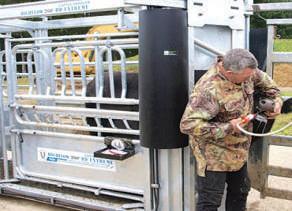
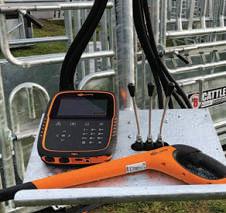



financial services, says for our children to have a brighter future,
we need to lift our game
Hamish Kerr had to first aspire to “fosbury flop” higher to win the Olympic high jump, and then he practised and practised and practised to achieve his goal.
New Zealand, across so many areas, needs to lift its game and productivity so we can have a brighter future for our children.
We have all played Limbo – a Tobago dance game in which you have to bend backward and go under a bar while staying on your feet. The bar is then lowered further after each time you go under it –exactly opposite to the high jump
Unfortunately, lowering the bar appears to be acceptable to some. “Camels are on the Horizon,” the great words from the founder of Dubai, Sheikh Rashid, describes this well.
“My grandfather rode a camel, my father rode a camel, I ride a Mercedes, my son will ride a Land Rover, my grandson will ride a Land Rover, but my great-grandson will have to ride a camel again” and asked why, his response was “hard times create strong men, strong men create easy times, easy times create weak men, and weak men create difficult times Many will not understand it, but we need to create warriors, not parasites.”
The foundation of any society and economy is the children. They are tomorrow’s leaders and entrepreneurs and risk takers
If our children are not educated and remain financially illiterate, our country faces a looming crisis.
School attendance statistics are alarming Friday-itis – where students are absent on a Friday – is rampant Little wonder workers are absent on Friday too. They get taught it by not attending school.
Nationally, 51.3% of students met the criteria for regular attendance (present more than 90% of the term) for term three of 2024 The figures show a strong ethnic divide with only 37.5% Māori attending regularly and only 39.5% for Pacific students.
The OECD’s 2024 Economic Survey of NZ reported that “Between 2009 and 2022, New Zealand’s average score in the OECD PISA test fell by the equivalent of approximately two years of education in mathematics, 18 months in science and one year in reading OECD research shows aggregate productivity may fall by nearly 4% as a result”.
Imagine running your farm or business


and being told you are about to become 4% less efficient.
On any given day of the week, there can be 140,000 students absent from school.
With that in mind, I note that on March 4, 2025, a New Zealand Herald article’s first two sentences were: “Principals from schools in the country’s poorest communities have united to call for an end to new NCEA reading, writing and maths tests. They warn the online tests will create a generation of school-leavers with no qualifications and most will be Māori or Pacific.”
There are huge issues in education, including equity and equality. More time and money needs to be spent on the lower
“
The foundation of any society and economy is the children. They are tomorrow’s leaders and entrepreneurs and risk takers.
Economist Gordon Stuart
end. Absenteeism is higher in poorer socioeconomic regions. Societal problems such as poverty and housing unaffordability impact school attendance.
However, we can only point the finger externally so far. We need to get the basics of education right. That means attending and measuring progress.
Those calling for the removal of testing, appear to want to lower the bar further, even as more than half failed the reading and writing tests and nearly three-quarters failed the numeracy test. Without passing the tests none of those students can get an NCEA qualification.
I am sorry, but such tests are part of working and sporting life. Originally in
School Certificate only 50% passed, and commonly at university people have to repeat papers. If you fail your driver licence you have to sit it again.
In all trades there are minimum compliance and safety standards you have to meet – we don’t need more unqualified idiots undoing three of the four bolts on a Transpower tower only to find it falls over on your farm.
We need a complete change of attitude in education as well as culture at home and school – we know who these kids are –now we need to get in and help them pass the tests, else they are destined for crime and a lifetime of social welfare support the country can’t afford.
Worse still, Māori and Pasifika are among the most naturally gifted athletes on the planet, if they don’t learn these skills and develop resilience they will never achieve sporting prowess.
Extra time spent at primary, intermediate and secondary school, and home to help these kids is money well spent – it is better to have a fence just before the top of the cliff so stock or kids don’t fall down it.
The minister of education is on the right track putting structure, accountability and measurement back into education. Businesses and the farming community need to get behind it. The future of businesses and farming is hugely dependent on it. Today’s kids are tomorrow’s leaders.
Jane White
Iwould like to make some comments on the opinion piece from Doug Edmeades in the March NZFarmer.
He states that clover-based pastoral farming returns large amounts of organic material i.e. carbon to the soil
Like him, I believe this to be the case. Why then is it not recognised when
calculating our carbon footprint and emission targets?
He also states, and I quote: “We are now allowed to use the tools of gene technology which, relative to conventional plant breeding techniques will greatly speed up the development of new plant material”.
Really?? What does he know that most of the New Zealand public don’t?
My understanding is that the Gene Technology Bill 2024 is now before select committees and has not been passed in to law yet
There were over 15,000 submissions to the Health Select Committee, many of them very opposed to this bill.
I’m sure there would be many more opposed if they were even aware of it. We should not accept that is just a
done deal. It has long been known that New Zealand does not have to feed the world but does feed those that are willing to pay a premium for the pasturebased, GMO free, natural food that we produce.
We lose our GE-Free status at our peril!
Jane White, Central Hawke’s Bay.
Meet theNeedisa charity foundedand ledbyfarmers, with amission to help fight food insecurity in NewZealand.

2.3+million
mince& milk meals delivered

We offerfarmers asimple platform to donatesurplus livestock,milk, or funds.These donations directly support thosefacingfood insecurity across thecountry.

food banks& organisations
By partnering with localfood banksand community organisations,ensurethat nutritious proteinreaches thoseinneed.One in five childrenare currentlyfacing food insecurity
Just one cowcan provide555 mealsfor familiesinneed.You candonate livestock,milk or cash -with100% going directly towardsfeedingthosewho need ahelping hand.
Visitushere
Some hope is in sight for droughtaffected farmers in Northland, Waikato, Manawatū-Whanganui, Marlborough and Tasman.
On March 6, Agriculture Minister Todd McClay declared a mediumscale adverse drought for these areas.
“The good news is in the last week of March and early April, there are hints of rainmakers making it over the North Island,” MetService meteorologist Katie Hillyer said.
“They won’t get incredible rain soon, but there is a hint they can get back to normal levels you could expect at this time of year.”
Hillyer said that in recent months, higher than average pressure centres in the Tasman Sea had prevented rain falling in western parts of the North Island, particularly in Taranaki and Waikato, as well as in the upper South Island.
Her news provided some hope for farmers hard hit by the conditions, particularly, according to Federated Farmers board member Mark Hooper, new contract milkers.
“Tough decisions are having to be made,” Hooper said.
“Like drying dairy herds off much earlier than usual, which will have big financial implications for the rest of the season.

“In some areas, winter feed is being used now, which could create further issues with possible feed shortages later in the year.”
Maize crops through the western and central North Island had held on quite well and were being harvested now, which would help, Hooper said.
“It’s safe to say the drought has really taken the gloss off what was shaping up to be a great season for dairy farmers ,with the high milk price.”


Waikato Federated Farmers president

Taranaki farmers had been most heavily affected by the dry weather.
“The rain can’t come soon enough,” Taranaki Federated Farmers president Leedom Gibbs said. “[The drought] is causing considerable mental strain.”


Keith Holmes said a good dairy payout was often followed by a drought – and this appeared to be the case.
Dry conditions existed all the way through to Dargaville, and the situation in Northland was worsening.
“We need 100mm of rain and a month of rain to get back to neutral,” Holmes said. “[Dry conditions] don’t normally go this long in the Waikato – it’s getting pretty grim.


“We’ve had pockets of drought in the last 15 years. This one has caught farmers off guard.”
Manawatū-Rangitikei Federated Farmers president Ian Strahan said the southern part of the region was “very, very dry”, with no grass growth.
“Sheep and beef farmers have been getting rid of stock early or shifting them






“Tough decisions are having to be made ... in some areas, winter feed is being used now, which could create further issues with possible feed shortages later in the year.
Mark Hooper, Federated Farmers board member




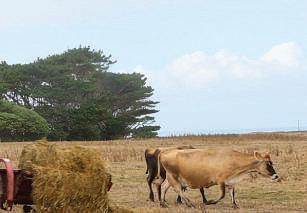




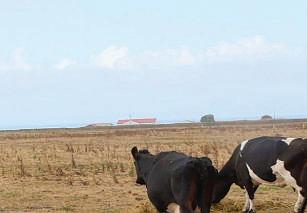


A very dry paddock in Tasman District. Feed will be light going into winter for drought-affected farmers in Nelson, Tasman and Marlborough.
BRADEN FASTIER/ NELSON MAIL



to other paddocks. Things are very tight.
“The northern and middle part of the region are not too bad – it’s dryish, but not a drought. A lot of the region is OK – parts that are having difficulties are very bad.”
Strahan said that over the whole region, he would classify it as a one-in-10-year event. For those most affected, it would be a one-in-10-to-20-year event.
He said the Rural Support Trust had helped a steady flow of farmers seeking assistance.
“In all sectors, beef, lamb, dairy are having very good prices. Some are coming out of a three- to four-year downturn and getting back on their feet. Arable are battling, pricewise, but there is general confidence in all sectors.”
As well as coping with drought conditions, Strahan said there was a “dark cloud” of uncertainty with the Trump administration in the United States imposing tariffs on red meat.
“Politicians are over there [in the US]

saying the right things. It’s very important that we don’t get those tariffs.“
Nelson Federated Farmers president Stephen Todd said drought-like conditions were “pretty general” over the whole Nelson region.
“Some people are saying it’s dry – others are saying it’s more dire and they’re struggling.
“We will be light on feed through to the winter. Winter crops are shrivelling, and the yield will be down.
“Before the dry, it had been an average year. We had a reasonably tough spring but came through all right.
“Fortunately, there has been feed available in Canterbury, which has had a pretty good year. Mid and North Canterbury were tough for a while but improved. The GreyValley (on the West Coast) has been particularly dry.
“We’re desperate for rain. If this continues, it will have a profound effect on production for next season.”


It has been back-breaking work at times but a Northland couple have transformed a duck hunting block into something unique. By Steve Macmillan
Having spent almost eight years creating a unique paradise at Maungatapere, a Northland couple now want to slow down and hand the mantle to someone else.
Hugh and Pauline Rose have turned their property upside down in the best possible way and created a niche business selling anything from seeds to cuttings, rocks, banana palms, pineapple plants, water lilies, lotus and more.
What was once a duck hunting block, thanks to a substantial raupō swamp surrounded by large areas of rock piles dumped on the land from neighbouring farms over the decades, is now a meandering area of discovery. Keen birdwatchers can now spot bittern, grebe, scaup, swans and lots of ducks.
They call it Land of the Lotus, a 24-hectare tropical paradise complete with water gardens, banana park and more.
Over the years they have created eight lotus ponds you can walk around, and added a solar-powered glamping cabin tucked away in the native bush and complete with outdoor kitchen and a private garden.
Discounts are even available if you want to help around the gardens. Camping is also an option, as is a self-contained unit with power and wi-fi.
Pretty much every corner you turn in the garden area has a pleasant surprise or a twist you wouldn’t expect. And it is all down to the backbreaking effort Hugh and Pauline have put in to making something so unique.
According to Hugh, the business is ripe for someone to take it to another level and add a cafe to the mix – so they can slow down and see their grandchildren.
But then Hugh has recently discovered Arabica coffee trees and is keen on looking into their potential, so his ability to slow down is questionable.
“We were living on a beef unit at Parua Bay and looking for a place with a good
water source for Pauline’s lotus and water lilies and preferably some native bush and shelter. We did so by Googling various properties around Northland. That’s how we discovered it,” says Hugh.
Hugh enjoys playing with water and building bridges and ponds, so has had great fun creating an environment where he can chill out looking at fish and listening to frogs and native bird song.
Part of cleaning up the property involved loosening rock piles and selling anything from trailer-loads of rocks to large feature rocks for gardens or driveway entrances.
In the decades before they took on the property, bulldozers had piled rocks from surrounding farmland and farmers then covered them up with soil. Over the years, cattle exposed the rocks again, leading to bony paddocks struggling to grow grass (or bananas) so Hugh has made good use of the paddock rocks, selling quite a few truckloads over the years.
Pauline jokes that if a rock is beautiful to someone, it must be expensive, especially because customers love having a feature rock in their garden to look at!
“Let’s face it, rocks don’t rot. They just sit there and they can be pretty useful for retaining walls and garden edging,” says Hugh.
A typical and sizeable feature rock sells from about $200 to $500, plus his digger time, Hiab and transport costs.
“Early on, I also identified that we could grow bananas well in New Zealand. I spent years driving around Northland looking for clumps of bananas in backyards, and I wanted to grow bananas here commercially.”
His “poke and hope” philosophy seems to have worked well, with about 1000 clumps of 50-odd varieties (blue, striped and Pisang raja, red dakka and red Jamaican dwarf included) now flourishing.
The couple sell thousands of pineapple, lotus and waterlily plants a year and they are told by one of their water plant suppliers

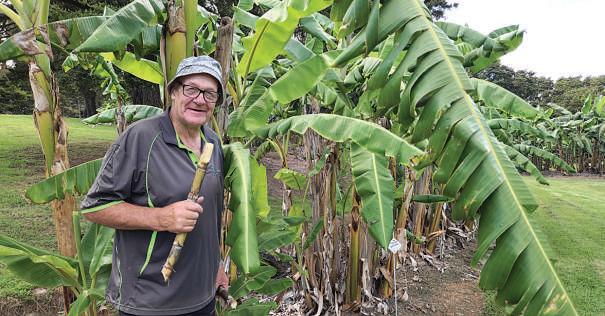
that they are selling more than all of Auckland combined.
Hugh has even become a hired gun as a consultant for others wanting to grow pineapples and bananas, helping people set up their plantations.
“In other banana-growing regions, I put them on to established growers in their area so they can source plants locally and I carry on having a holiday in my campervan.”
He has also become something of a whiz in being able to work out the whakapapa of the plants, another facet of life on the land he enjoys immensely.
“Specialty bananas are selling really well just now and rocks and water lilies have been good sellers this summer,” the pair say. Demand for theirvarious products changes all the time and the couple just roll with it – always with beaming smiles and
Above:It’shardto wipethesmileoff HughRose’sface whenhespeaks ofthejourneyin creatingasliceof paradiseinthepast eightyears.
Left:HughRose withapieceof sugarcanegrown ontheproperty.He plantedsomeas itwasaplantthat piquedhisinterest.
plenty of enthusiasm for doing what they love.
Someone in Oamaru has produced fruit from their pineapples, and their pineapples and bananas are flourishing in Invercargill.
As Pauline points out, from the steps of their shop which carries an array of niche products, it is about diversified income, including supplying numerous food forests over the years.
Koha or donations are appreciated for a walk in the gardens and tropical plantations and guided tours are $5 a head. Most people buy products and leave with plants of some variety, she says.
“People who are from tropical countries overseas say it’s like walking through a plantation in Asia – often that it reminds them of their homeland – and they all leave happy.”
Matthew Dallas
When challenged to craft a picture book, Tim Saunders didn’t have to look far for inspiration – it was right beneath his seat.
“I drove from one side of the paddock to the other side of the paddock, and it all came to me,” said the author and fifthgeneration Manawatū farmer
On the face of it, The Tractor Has a Wobbly Wheel was a left turn for Saunders, who is an acclaimed short-story writer and poet.
His two previous books, This Farming Life and Under a Big Sky, both non-fiction, delved into the pressures of rural life, climate change, and evolving farming methods, knowledge gleaned from working the family’s 280-hectare lamb, beef and crop farm at Glen Oroua.
When his publisher proposed a picture book, Saunders was initially coy. But he soon realised his familiarity and affection for rhythm, rhyme and brevity put him in good stead.
“Words have to be chosen very carefully and have to invoke something, especially with children’s writing.
“You can’t have long passages of description. You’ve got to pick one word to represent a whole lot of feelings – and I find that a lot of fun.”
Saunders, 47, had studied TV and film at Avalon Studios, specialising in children’s television. He worked on perennial Saturday morning favourite What Now
The leap to books was a comfortable one, he said.
The Tractor Has a Wobbly Wheel, vibrantly illustrated by Carla Martell, tells the story of a tractor, its troublesome tyre and the efforts of the farm animals to remedy it, only for things to go from wobbly to clumpy, lumpy and worse.
Through buoyant rhymes and alliteration, Saunders offers a wry farmer’s assessment of machinery: If it can go wrong, you can bet it will.
“You hardly have a day without some sort of breakdown.”
The tale was inspired by real events When one of his tractors blew a tyre during lockdown in 2021, he was left looking at the livestock for answers.
“Because they’re such a specialised thing, someone has to come out and fix them. They’re so big.






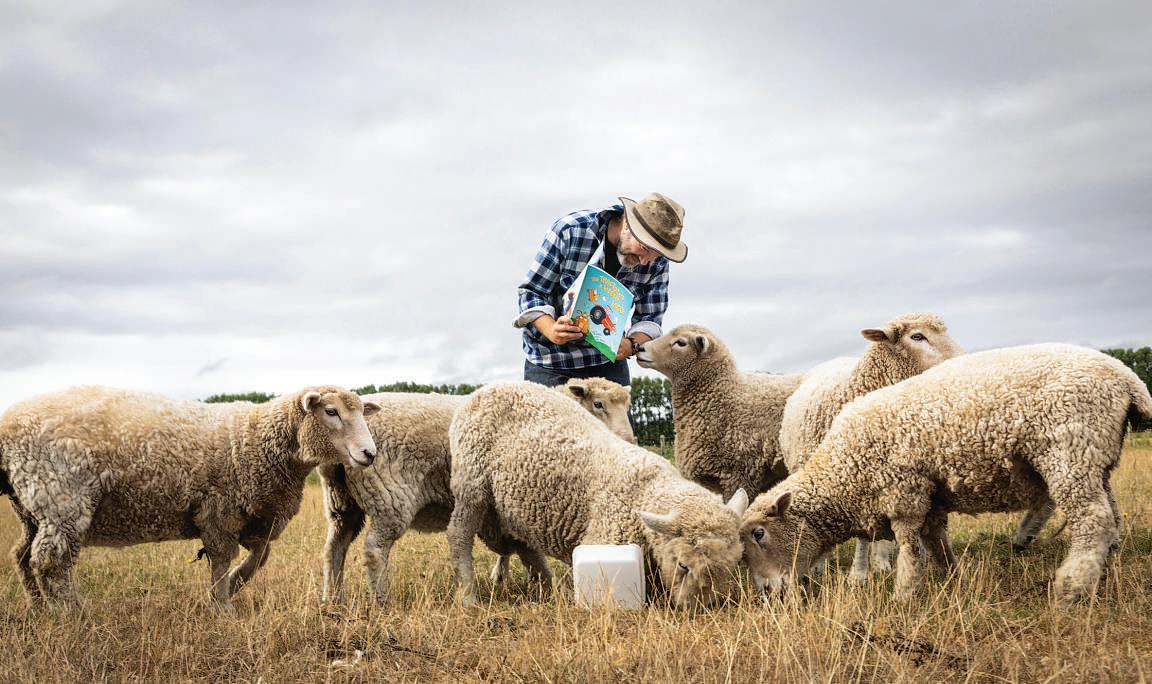
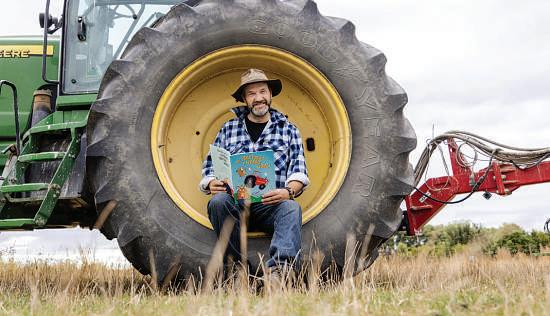
“It’s not like a car tyre that you just take off yourself.
“And I thought, what am I going to do? I looked around – I wonder if the animals can help? But they didn’t.”
Saunders doesn’t have children, but fondly recalled the picture books of his childhood and being read to by his grandmother who lived next door.
“I used to disappear over there all the time and she’d read to me. And my
“You’re just sitting there and there’s the drone of the tractor, and you have the radio off, and you can go into your own mind and come up with things,” says Saunders of the creative benefits of driving tractors.
PHOTOS: ADELE RYCROFT/MANAWATŪ STANDARD
parents always knew, if I was missing, that’s where I’d be.
“I grew up with kids’ books. I was read to a lot. That’s where my love of writing came from, from being read to and then reading myself, and then wanting to do it myself.”
He delved into many of those old stories, favourites such as Bears in the Night – a Berenstain Bears tale – with its propulsive repetition, and sought out

more modern picture books to see how they had evolved.
The Manawatū Standard asked whether Saunders, given his livelihood, had been tempted to give farmers their due as characters instead of anthropomorphising livestock, but he confessed to being “a bit of a sucker for talking animals”.
“And the beauty of having animals [is] anyone can read it. You’ve got no gender issues, no race issues, anything like that It’s a very inclusive way of writing.”
Allen & Unwin New Zealand’s publisher at large, Jenny Helen, said Saunders was a wonderful writer who had tackled many genres. She had been interested to see what he could create for children, combining his writing ability and farming knowledge.
“He didn’t disappoint. I love the way he’s written this very jolly, happy, fun book for children, bringing together two favourite topics – tractors and animals.”
The Tractor Has a Wobbly Wheel, aimed at children aged 3 to 6, is now available at bookstores, and Saunders is already ploughing into his second picture book.
Andy Brew
Havelock’s Maegen Blom says she is “really stoked” to be the first aquaculturist to win the coveted Trans-Tasman Zanda McDonald Award.
Blom, 24, is the operations manager for family-owned Mills Bay Mussels She said she found out she had won via social media last week after the awards ceremony on the Gold Coast was cancelled due to Cyclone Alfred.
“The reality of it all still needs to sink in, but I’m quite chuffed,” she said.
The Zanda award recognised “exceptional young leaders” from the primary sector and was open to “passionate” and “determined” individuals aged 21 to 35 years who worked in the agri-business sectors of either Australia or New Zealand.
Blom said she was passionate about the aquaculture industry. Her day-today role involved organising greenshell mussels supplies to restaurants, wholesalers and supermarkets across New Zealand.
“I love food, which was probably
the beginning of all of this,” she said.
“I also really like farming but I’m most interested in the post-harvest aspect of farming – what happens to the food or the products when they leave the farm –that’s the space that I work in at Mills Bay.”
Blom said she had been involved with Mills Bay Mussels since her parents bought the business about eight years ago, but had been operations manager for the past 3½ years.
“I get to work with really cool people,” she said
“I’ve got an awesome team and some really quite interesting customers and we have got strong partnerships and great people in the industry.”
Blom was also recognised for her role as a founding member of Young Fish NZ, a networking group that helps connect people aged under 35 in New Zealand’s aquaculture and fishing sectors.
“There’s plenty of young people in the industry, but they don’t really know each other, so Young Fish was basically formed to connect them and then from there, who knows what those connections will bring,” she said.
As part of the prize, Blom will also receive a personalised development

package, including a bespoke mentoring trip across both Australia and New Zealand and $10,000 towards further education or training, media coaching and ongoing networking opportunities. Award chairperson Shane McManaway
praised Blom for being “incredibly focused, passionate and driven to create meaningful change” in her industry.
“Maegen’s leadership in a maledominated industry is outstanding,” he said.
Some of the brightest minds in science were in the spotlight at the Science New Zealand Awards 2025.
By Sonita Chandar.
Aplant technology company that has been a major contributor to the success of New Zealand agriculture for more than two decades earned the supreme honour at the 2025 Science New Zealand Awards.
AgResearch subsidiary Grasslanz Technology Ltd, which has made a significant contribution to the economy and environment, was named last month as the supreme award winner in recognition of its record of introducing valuable new types of pasture and related technologies that have helped livestock industries to thrive.
The Science New Zealand Awards celebrate science, innovation and technology excellence and the impact across the public research sector (crown research) and the people and teams whose research and innovation makes a difference not only for New Zealand, but also the world.
The finalists and winners represent the best of New Zealand’s scientific talent, growing the economy, looking after the
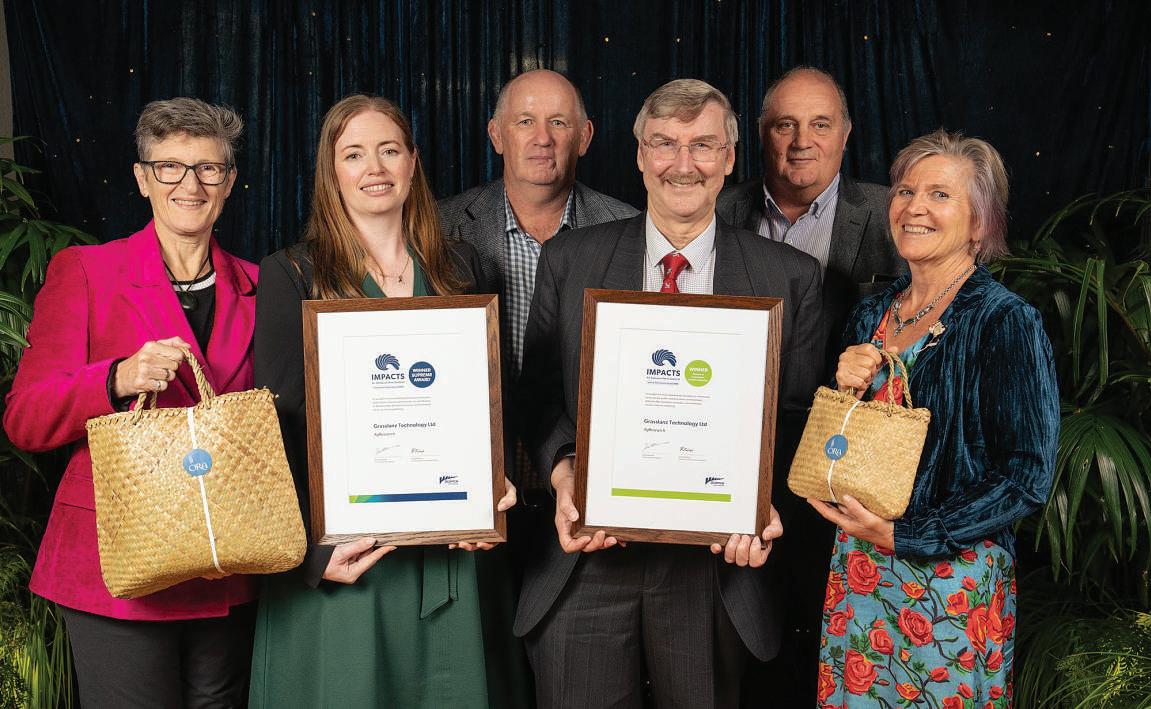

environment and creating a fairer New Zealand.
The theme of this year’s awards was ‘impacts for Aotearoa New Zealand’, recognising the research driving innovation and tangible outcomes that benefit New Zealanders.
Researchers often collaborate across institutes and with industry to tackle important challenges and grow opportunities for New Zealand, pooling their knowledge, expertise, experience and insights. The awards recognise research teams that include partners from communities, business, iwi, and local and central government.
Dr Shane Reti, the minister of science, innovation and technology, said, “I see huge potential to grow our economy through adopting better ways to bring together our science and technology talent pool and create a dynamic system that can respond to priorities and keep pace with technological advancement.
“I firmly believe the science system has a key role in taking New Zealand’s future opportunities and to apply our excellent science. I am committed to supporting and advancing the critical contribution of the sector.”
This year’s Science New Zealand Awards honoured 40 finalists across five award categories: Collaboration for Impact; Success in Innovation/Commercialisation; Individual/Lifetime Achievement; Early Career Researcher; and Te Tohu Tūhura (Charter a Course for Impact through Partnering with Māori). The Supreme Award winner was chosen from the winners of the five award categories
Part of the contribution Grasslanz has made;, is the commercialisation of the AR37 Epichloë endophyte developed by AgResearch scientists, which provides resistance to pests and has been
“ ... the science system has a key role in taking New Zealand’s future opportunities and to apply our excellent science.
Dr Shane Reti
independently estimated as contributing $3.6 billion to the New Zealand economy over the life of its 20-year patent.
“This award is a real credit to the many people who have been a part of the enduring success of Grasslanz Technology,” Grasslanz Technology chief executive Megan Skiffington says.
“That means everyone from the science teams who made the discoveries and did the research, through to those who partnered with us because they believed in turning this research into products that farmers and growers can use to enhance the productivity and sustainability of agriculture in this country.”
Reti said the winners and projects showcased at the awards underscored not only the quality of the science, but also the positive impact it could have on New Zealanders.
He also said it was an exciting time for the science system following repeated reviews which pointed to changes that are needed

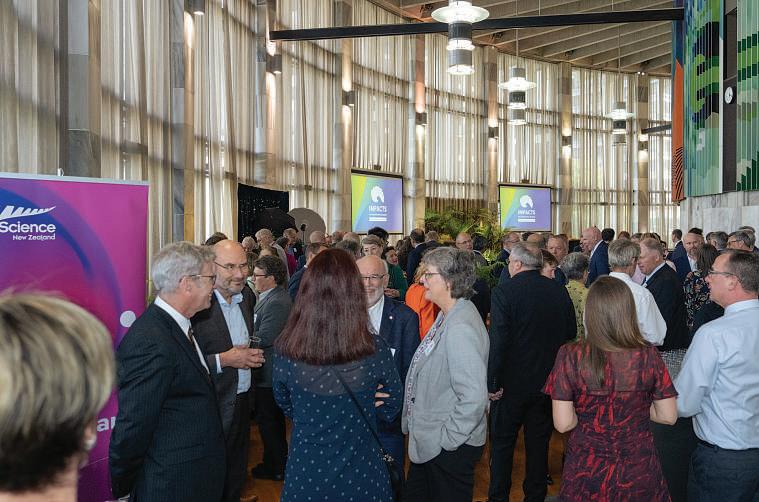
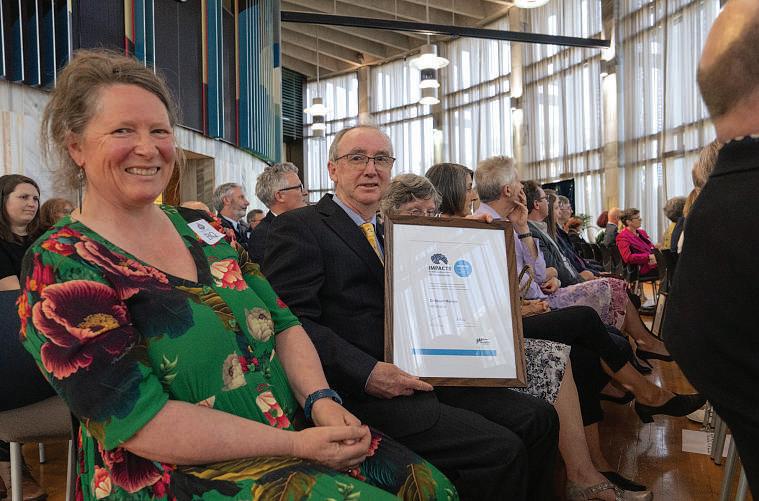
to the architecture of the system to unlock the potential of our science to provide the greatest impact to New Zealand.
The Government announced earlier this year that the seven crown research institutes will soon be merged into four new Public Research Organisations, including one that includes AgResearch and is focused on the bio economy.
Skiffington says this new structure presents exciting possibilities for Grasslanz to grow its reach and seize other opportunities to bolster the primary sector. This includes opportunities using technologies such as genetic modification and gene editing in pasture and beyond.
“We know that farmers and growers do better when backed by great science. With our partners, Grasslanz has delivered that impact on the ground. We think we will be able to bring even more value to the new Public Research Organisation with our proven business model, helping a larger pool of scientists to provide solutions to those farmers and growers.”
Category award winners were:
Success in Innovation / Commercialisation
Grasslanz Technology– AgResearch for the AR37 Epichloë endophyte
Grasslanz Technology is a plant technology company turning scientific breakthroughs into solutions for farmers and growers. Alongside its partners, Grasslanz has developed safe methods to enhance plant growth, improve resilience to stresses like drought, and increase resistance to pests and diseases by creating endophytes that protect crops without synthetic chemicals.
Collaboration for Impact
The Bio resource Processing Alliance (BPA) – Callaghan Innovation
The BPA transforms primary sector by-products into higher-value products, diverting more than 100,000 tonnes of waste from landfill annually. It has facilitated more than 20 commercial launches. Its innovations have attracted capital investment, created over 115 jobs, and commercialised projects valued at more than $100 million Spanning forestry, marine, agriculture, horticulture, dairy, wool and meat, the BPA shows the broad potential of collaborative innovation.
Individual/Lifetime Achievement
DrStuart Henrys – GNS Science
Geophysicist Stuart Henrys leads groundbreaking research on the Hikurangi subduction zone, New Zealand’s largest fault line, which poses a 26% chance of a mega-thrust earthquake in the next 50 years. Henrys has transformed this data-poor region into one of the world’s most surveyed subduction zones, using advanced seismological techniques like a 3D “CAT scan” of the Earth’s crust to deepen understanding of the conditions that generate subduction earthquakes. His
leadership in international collaborations has helped create foundational datasets that underpin high-profile scientific projects. His work enhances earthquake predictions and preparation, contributing to New Zealand’s reputation as a world leader in geoscience.
Early Career Researcher
Joint winnerDrGenevieve Coffey–GNS Science
Genevieve Coffey is an earthquake geologist whose innovative use of paleoseismic data offers vital insights into earthquake behaviour. Her pioneering research on fault biomarkers helps understand seismic hazards, uncovering the history and potential of faults to host large earthquakes. Her work supports critical initiatives like the National Seismic Hazard Model that help us prepare for future seismic risks.
Joint winnerDrHilaryIreland –Plant & Food Research
Dr Hilary Ireland is a rising star in plant molecular biology whose research aims to develop innovative products like coreless apples and fruits that do not rely on insect pollinators. This research could lead to fruit varieties that can be grown in a range of environments, including indoors. As a leader in early-career researcher groups, she advocates for her peers.
Te Tohu Tūhura (Charter a Course for Impact through Partnering with Māori) Joint winnerManaaki Whenua Landcare Research
This five-year partnership found that a new kānuka industry has the potential to create economic and employment opportunities for Māori in remote areas, along with new land-use options. The partners developed a new eczema treatment cream with 3% kānuka oil, which a 2022 clinical trial found significantly reduced eczema severity. It also led to the creation of Hā Kānuka, a national entity that represents all kānuka producers in Aotearoa, and has created a roadmap to help other hapū and iwi develop industries from taonga species.
Joint winnerHikurangi Bioactives Ltd Partnership
This research partnership has mapped the exposure of Porirua’s Takapūwāhia community to natural hazards, with project outputs already helping to protect people and property. The Takapūwāhia impact assessment team collaborated with tangata whenua and community members to determine how they could help This ground-up approach led to hazard mapping, a street survey, an assessment of potential emergency supply sites, identification of buried river channels, planning sites for community gardens, and assisting their most vulnerable individuals. The community now know where natural hazards are likely to affect them and where to locate their emergency response containers.
McArthur Ridgeisone of the world’s southernmost vineyards.
It’saplaceofextremes, bitterly cold in winterand scorchinginsummer.Surrounded byragged snow-cappedmountains. Shelterless from the winds thathavestripped theland bare. Whatcould possibly grow here? Even the fewscragsofwildthyme hide in nooks and crannies, wiseleyavoidingdirectexposure.
Frost constantly threatensthe grapes and farm equipmentbreaks on the bedrock.
Does thatsound like the land of ‘warm berries’and ‘sweet fruitsoftlyarticulated’?
Yetdespitethis brutal provenance, surviving thesestressful conditionsforcesour grapes to grow with such robust depth of flavour,you can literally tastethe life in it.
It’sseen our Southern Torpinotnoir rack up theawards, includingBest In Showatthe prestigious Decanter World Wine Awards in London,the ‘Oscarsofthe wine industry’. So if youhad been wondering whywebother when it seems the odds arestacked against us. We exist at theedgeofwhat’spossible. To be on top, we risked everything going south


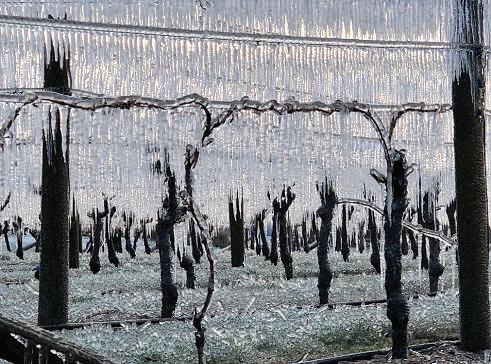





Innovation
Louisa Steyl
Aproduct developed in Orepuki has been snapped up in the United States Entrepreneur and deer farmer Grant Lightfoot is fielding orders for his edible bale wrap, with one Texas farmer booking a whole container-full
“It’s just mind blowing,” Lightfoot said “It’s gone crazy.”
It’s an innovation he has been tinkering with for some time, but he reckons he’s “cracked it” with his first container of the product arriving in New Zealand last month.
Kiwi Econet, the eco-friendly, edible bale net made from flax fibre, won first prize for environmental innovation at last year’s Southern Field Days.
The win caught the attention of overseas investors and Lightfoot spent the next few months “dotting i’s and crossing t’s”.
He has been distributing his first shipment of Econet in Southland and Otago but there had already been heaps of interest from abroad, he said, with 14 calls from the United States in just one morning.
“I’ve got to start thinking about the rest of the world now. This is getting scary.” Lightfoot got the idea for the edible wrap after finding plastic netting in the stomach of one of his cows He and his partner spent months finger-knitting 50 metres of flax
Opinion Blair Rooney
AI is everywhere. Every week, another company claims their latest feature is “powered by AI,” promising revolutionary change. But as someone who works in the agri-tech sector, I urge Kiwi farmers to approach these claims with a healthy dose of scepticism.
The agricultural sector has seen its fair share of technology trends come and go, and AI may be no different. Some innovations genuinely move the needle; others are little more than marketing hype, using flashy bells and whistles designed to attract attention, rather than real, material improvements to the product.
The hype around AI often obscures the fact that many companies are chasing trends rather than delivering value. So, when a company suddenly starts touting AI, farmers should ask: Is this a wellintegrated tool designed to solve real problems, or is it a quick add-on to ride the AI wave?
Right now, much of what’s branded as AI in agri-tech is simply repackaging of existing technology. Many solutions are just large language models plugged into dashboards to generate summaries or “insights.” Sure, it might look impressive at a glance, but does it measurably improve the user’s ability to make decisions or boost productivity?


Orepuki farmer
Grant Lightfoot with his Kiwi Econet edible bale net product, which won the open section environmental award for innovation at the 2024 Southern Field Days
ROBYN EDIE/ SOUTHLAND TIMES

fibre as a proof of concept but once he rolled his first bale, he knew he had found a better alternative. He’s run multiple trials over four years to perfect the structure and strength of the net and to make sure it was clear of contaminants like plastic or lead that may be harmful for animals to digest.
Prototype in hand, Lightfoot headed to India to visit a manufacturer.
“I told them what I wanted and in eight hours, it went from a concept to a roll. They had a roll of netting for me to take home in the plane.”
New Zealand’s agriculture sector produces more than 2.1 million tonnes of waste a year, of which plastic is the most prevalent rural waste, according to the Office of the Prime Minister’s Chief Science Advisor.
“Some farmers burn it, they bury it, some farmers just leave it lying around and then the contractors come back and you get that stuff hooked up in the machinery, it’s a headache,” Lightfoot said.
He acknowledged that his product was thicker than plastic netting and that the cost was slightly higher, but said farmers understood the trade-off.
“It’s better on animals and better on the environment, hands down.”
While he’ll catch the end of the season in New Zealand, Lightfoot is hoping his US business partner will help smooth distribution in the States, where he’ll be able to ship containers directly.

That’s the question we need to ask Genuine AI innovation requires years of refinement, practical application, and a deep understanding of user needs; something that can’t be achieved overnight or through marketing gimmicks. The risk for business owners, including farmers, is investing in tools that promise much but fall short when it comes to improving productivity or profitability.
At Farm Focus, we’ve been leveraging AI – though we never used the term at the time – for years to deliver real, practical benefits to farmers. For example, our machine-learning-powered invoice scanning feature accurately extracts key information from farmers’ receipts and inputs it into the system automatically. No manual entry required. This is AI in action, quietly working behind the scenes to save farmers time and hassle. It’s not shiny or trendy, but it works – and our customers appreciate that.
That’s the standard we hold ourselves to when developing new features or
“Right now, much of what is branded as AI in agri-tech is simply repackaging of existing technology.
capabilities Whether it involves AI or more traditional product development, our north star is simple: will this actually help farmers? If the answer is no, we don’t pursue it.
Looking ahead, we’re excited about AI’s potential to enhance on-farm productivity and financial performance in meaningful ways. Dynamic forecasting and more interactive scenario planning are on our roadmap – not because AI is trendy, but
Left: Although the team at Farm Focus have never used the term AI at the time, they have been leveraging AI for years to deliver real, practical benefits to farmers.
Below: The head of Growth Marketing at Farm Focus, Blair Rooney, says AI has the potential to enhance onfarm productivity and financial performance in meaningful ways

because these innovations will make a real difference in financial planning for your day-to-day operations
At the end of the day, farmers don’t need tech for tech’s sake. They need tools that they can trust, that solve real problems and are grounded in the practical, Number 8 wire spirit that drives New Zealand’s rural sector. Farmers deserve better than gimmicks They deserve tech that works as hard as they do.

Sonita Chandar
Despite a lift in farmer morale and increased payouts, farmers were not throwing caution to the wind and spending up large at the Central Districts Field Days.
After hitting rock bottom in 2023, farmer confidence began to rise in 2024, and in 2025 it has rebounded and risen to a 10-year high, surging 68 points since July 2024 This points to farmers no longer feeling dismally gloomy about the future.
NZFarmer spoke to many farmers from various businesses and found most were feeling positive about the agriculture industry.
However, several dairy farmers told NZFarmer that despite the very welcome drop in interest rates and the increase in milk and commodity prices, they would not be “going crazy or opening their wallets just yet”.
Several said that, instead of buying new farm machinery, tools or even a new ute, they would focus on paying down debt so that when the next cycle of lower prices came, they would be in a better financial position to ride the tough times.
NZFarmer did speak to several farmers who had made purchases and they all said they were pleased with the deal they got, although one mentioned his wife might not be terribly happy with him as she was wanting a holiday after a few years of staycations.
Another said the reason he forked out for a new tractor was necessity.
“If I hadn’t needed it, I wouldn’t have bought it and, to be honest, I wouldn’t say it was a really good deal.”
As the three-day event billed as the “best day off the farm all year” wrapped up for another year, planning was under way for 2026, with exhibitors already securing their spots.
“We had more than 25,000 people attend this year – with visitors seeking out specific deals, others coming for new activities such as the Golden Loader and Strongman competitions, through to monster trucks,” event manager Jonathan
More than 25,000 visitors streamed through the gates of the Central Districts Field Days in 2025 to check out all the latest developments, innovation and technological advancements in the rural sector EVENTS
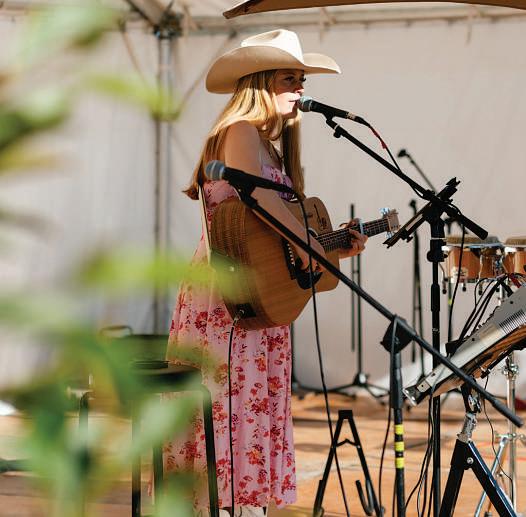


Paul said “CD Field Days is the largest regional agricultural event, and a test of the mood of both the region and the sector. Both exhibitors and attendees were upbeat, with talk of ‘survive in ’25’ becoming ‘thrive in ’25’.”
Hosted by Stuff, the Central Districts Field Days (CDFD) are a unique and important part of farming business. Each month farmers connect with
The Central Districts Field Days are a great place to score a good deal or have a day out with mates.
wider agricultural industry. Exhibitors reported steady trade, and many told NZFarmer that they had many inquiries to follow up on-farm in coming weeks.
And with the event boasting more than 500 exhibitors, as well as a number of competitions and attractions, there were plenty of new trends and developments in rural innovation, agribusiness and agritech for visitors to check out.
Farmers were well catered for, with plenty on offer from exhibitors showcasing tractors, silos, quad bikes, large and small machinery, wet weather gear, tools and gumboots.
Lifestyle sites sold everything from socks and hats to artisan foods and locally crafted brews.
“There is always a mix of high-end purchases through to people wanting to have a chat over a beer, and based on the feedback as we went around Manfeild, exhibitors had busy times across the three days,” Paul said.
agribusinesses throughout the country through the national farming newspapers NZFarmer and AgTrader, and, more frequently, through the Stuff website.
CDFD is another tool in connecting farmers with help in the successful running of their businesses and each year, thousands of visitors stream through the gates, in what is a long-established highlight for the Manawatū region and
“We heard about some great sales –tractors, vehicles, clothing, machinery and so much more.
“It was great to see the lanes of exhibitors busy.”
Paul said bookings from exhibitors were already being taken for CD Field Days in 2026.
“Mark your calendar for March 12 to 14.”


ay
Fi ys Matthew Dallas


It’s not easy to turn heads when there are 500 exhibitors competing for eyeballs. But double-takes and wry quips are common reactions among the throng at Little Green Dunny, a nostalgic yet sustainable nod to the past nestled amid the myriad tents and massive machines at Central District Field Days.
It was the first time Matt and Rachael Dell, who run the Carterton-based venture, had brought their charming, rustic composting toilets to the sprawling agricultural expo at Manfeild.
“Today, just walking around, lots of people have stories about old outhouses,” said Rachael. “Some very funny stories. And someone came past and said, ‘Are they for real?’. So it’s a little bit confronting and challenging for some people.”
Though the sight of it may conjure memories of a smelly old long-drop, the Little Green Dunny uses a batch-bucket system. A sprinkle of sawdust and a quality lid mean no smell or fuss.
Anyone who buys one is provided with a guide to composting.
Dell said she challenged her husband to make a sustainable toilet when she was running a fundraiser event that she wanted to be zero-waste. Following its success, he became the “muscle”, and she the “hustle”.
Most of their business is in Wairarapa, selling to farmers and glampers, but the dunnies have been packed and shipped to both Waiheke and Great Barrier islands.
“Often, people buy a bit of land and actually what prevents them spending more time there, before they can build, is not having a toilet
“So we’ve sold dunnies to lots of people where they get so excited because, ‘Yay, we can stay on the land a bit longer’.”
The couple said they hadn’t known what to expect from Field Days, but enjoyed the banter and the opportunity to sell the idea of composting toilets.
“It’s always been a business goal to come here. We don’t do a lot of advertising – a lot of our business is word of mouth.”
Many passersby were stopping to admire the deluxe split-door model, a “loo with a view”, with one warning Dell that the display dunny looked so inviting that it might tempt someone to provide a demonstration.
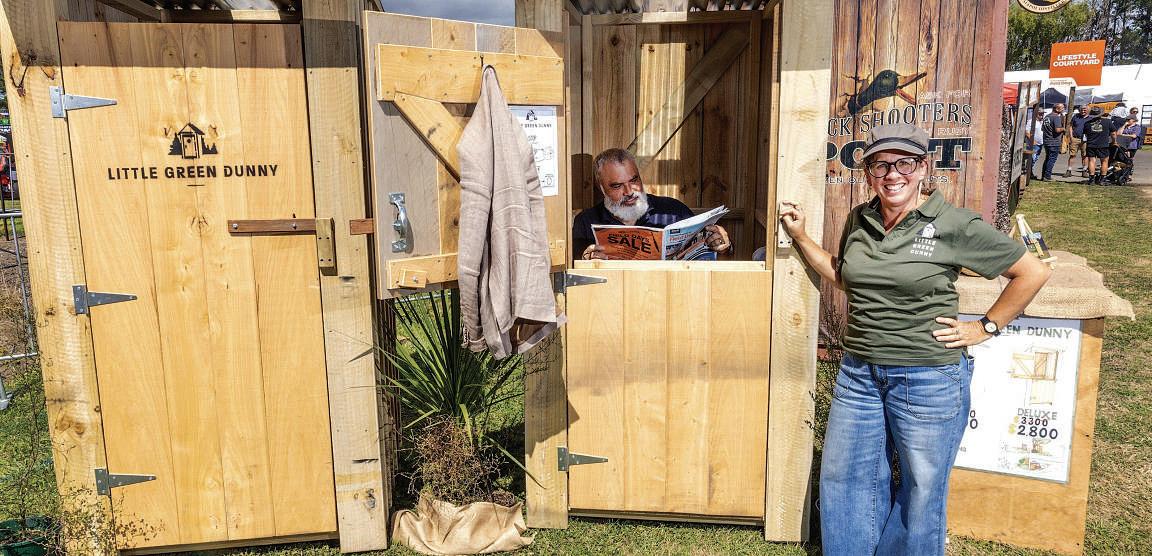

It was a fear she was already mindful of.
“That’s the thing, everyone has got to go to the loo – we just don’t want them to do it here,” she said, laughing.
Few CD Field Days personalities were more popular than Duckie and Oden at the Nightrave Greyhounds stand, despite their farm credentials being at the low end.
“They’re a super-lazy dog,” said Rachel Rae, who has been rehoming greyhounds with Nightrave since 2016
Andy Brew
Northland’s Steven George demonstrated his grit to rise above the field at the national excavator operator competition, outclassing 11 of the country’s top operators to reign supreme.
The Whangārei owner-operator showed nerves of steel and precision operating to clinch the victory at the Central Districts Field Days at Manfeild.
He took the title ahead of Bay of Plenty champion John Rohloff of Fulton Hogan, while last year’s runner-up, Michael Brown, also of Fulton Hogan, was third George’s success followed previous attempts in 2023, when he was runner-up, and 2024, when he was third
He said winning was awesome.
“Third nudge at this. I was second, dropped to third, and managed to get there.
I wasn’t too confident. I enjoyed watching all the other competitors. Everybody’s pretty skilled, eh?
“I don’t usually get nervous, but this evening was a bit of that.”
This year’s event marked the 31st anniversary of the excavator Battle Royale, and broke new ground, with three female regional champions – Georgia Lyford from Canterbury-Westland, Lydia Hill from Nelson-Marlborough, and Tanya Claxton from Hawke’s Bay-East Coast – competing in the national finals for the first time.
This time, competitors impressed spectators by completing amazing challenges, including the over-the-wire challenge, in which they had to construct ramps of earth to navigate over a wire, as well as the Connect Four challenge.
This jumbo recreation of the classic Connect Four game was a perfect showcase for the outstanding fine motor skills possessed by the regional champions.
Despite being synonymous with hurtling round racetracks, greyhounds were low-exercise dogs, she said. “You don’t walk your greyhound to the park and run him and walk home. You drive him to the park.
“A walk to the park and back is enough, otherwise they get too tired.”
Rae said greyhounds were a great fit for families with busy lifestyles, and people who wanted a calm, gentle dog. “They’re kind of a no-brainer for a lot of families. They’ve got
an easy-care coat, they’re quiet, they stay home while you work, they’re easy to walk.”
Rae said there had been a massive increase in inquiries in the wake of the Government’s announcement of a ban on greyhound racing, but this didn’t necessarily translate into adoptions.
There were about 4000 greyhounds nationally that needed to be rehomed, from puppies to retired breeding dogs, and Nightrave had 50 across both Feilding and Hawke’s Bay.
People who expressed interest in adopting a greyhound at Field Days were asked to fill out a questionnaire. This would be followed up with a home visit and a foster-to-adopt process.
Farming families from the wider Manawatū region, Hawke’s Bay, Taranaki, Wairarapa and Wellington attended the three-day expo, owned by Stuff and powered by Brandt.

Traditional crowd-pleasing tasks faced by the competitors also included painting, scooping ice cream on the 13-tonne excavator course, and popping a champagne cork to celebrate completion of the 5.5-tonne excavator course.
For the competition’s one-day job challenge, operators pushed their knowledge and skills.
Josh Keane of Otago-based McEwan Haulage was awarded the trophy for 2025,
winning over judges with his attention to detail.
The MVP award went to Lydia Hill, from Elite Excavations in Blenheim.
Invercargill’s Brad Fallow, from SouthRoads, won the Geoff Duff Memorial Trophy for a second year running. The trophy recognises the best scores across the truck-loading challenges, and commemorates Geoff Duff of Carterton, a former competition judge.








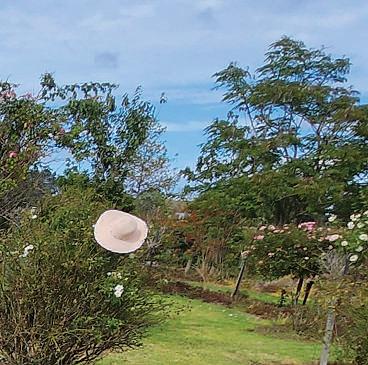
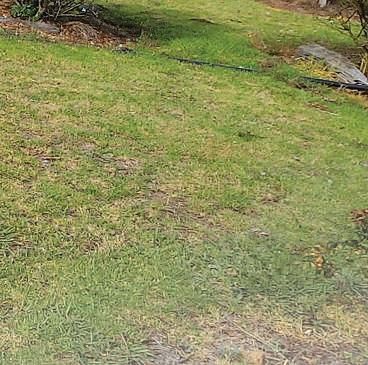

A serious accident involving a trusted horsehas not deterred a Northland woman from life on the land. By Steve Macmillan.
ADargaville woman who has spent her life on the land reckons animals should never be underestimated
Debbie Martin says they are great levellers and the moment you think you know everything about them, they will put you in your place.
Having spent her life farming, Martin has experienced plenty of occasions where she has been reminded of this
The most notable came in March 2024 which was the catalyst for her retiring from horse riding and breeding, something that had been a passion for decades.
While walking her 6-year-old horse around her arena, her usually placid horse bucked for the first and only time, sending her a couple of metres into the air
Add to the fact it was 18 hands high, Martin knew she was in trouble. She landed on her backside and for the first time in her life, she was unable to move.
“Basically, my pelvis was blown apart on impact. It is held together by screws now and it has been a tough recovery,” she explains.
Her daughter Lisa was visiting from London and heard her cries for help.
An ambulance was first on scene, followed by the duty doctor from the Dargaville Medical Centre and a Northern Rescue Helicopter which initially flew her
to Whangārei Hospital before transferring her to Auckland Hospital for more scans and X-rays.
“The pain was chronic and it was a few days before I was operated on. I then had weeks of recovery in Whangārei and Dargaville Hospitals, with five of those weeks on my back.”
It was not until late 2024 that she gradually returned to work driving milk tankers for Fonterra. Although she has not returned full-time, she still clocks up the miles driving up to 600km some weeks around Kaipara, Whangārei and Far North Districts
However, her roster can see her doing pick-ups at Kumeū, Helensville, Tomarata and on the odd occasion Pukekohe.
She is thankful she took up her husband Brian’s challenge 20-odd years ago to get her Heavy Transport Licence.
Back then they were milking 500 cows on 250 hectares (with a supporting 100ha run-off) and averaging 130,000kg milksolids.
“Brian thought it would free him up to focus on the farm work with me picking up gear for the farm, so he didn’t have to wait around for loads and have an unproductive time,” she says.
“I had always driven trucks but never had my licence.
“He said if I got my licence he would
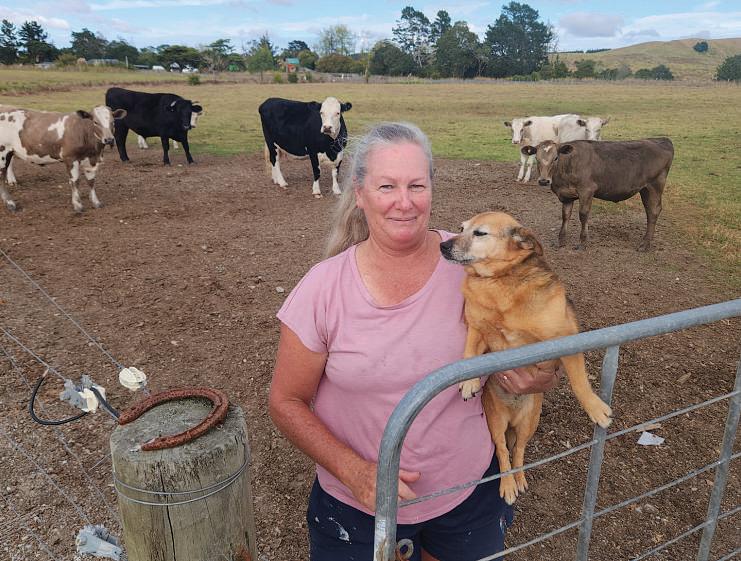
“
The pain was chronic and it was a few days before I was operated on.
Debbie Martin
buy me a horse truck. My mother had her licence and I had always been around trucks, so it made sense.”
Since exiting farming in 2013, Brian has been driving for Kevin Reid Contracting in nearby Ruawai and the couple have been developing their seven-hectare lifestyle block, with Martin’s increasingly sprawling garden taking pride of place.
Where she once had a dozen horses and would sell them for up to $20,000, she is now down to two horses, 15 sheep, 15 pigs
and eight mixed-age cattle which help pay the rates and put some food on the table.
She says she really enjoyed her time breeding horses and knowing that the people who bought them were receiving quality lines and well-trained animals ready for eventing – dressage, cross country or showjumping.
She was a talented rider back in the day, competing in the Horse of the Year many times and placing fourth and fifth on many occasions.
“I started out in Pony Club and did dressage for about 23 years. I rode advanced level dressage and even competed in a World Cup Challenge. The thing I liked about competing, just like my gardening and truck driving, is that only I need to be there, so it is my time out.”
In saying that, she recently took Brian on a ‘date’, which involved him riding side saddle on one of her tanker runs She has also taken her father Michael a couple of times As for horse riding and breeding, she has let the reins go.
Dairy Sonita Chandar
The New Zealand Dairy Industry Awards (NZDIA) have got even bigger and brighter with the addition of two new awards that will help farmers on their journey to farm ownership
The Fonterra & ASB First Farm Award (FFA) and the ASB Alumni of the Year Award (AAOTY) will bring the total national awards to six, including the New Zealand Share Farmer of the Year, New Zealand Dairy Manager of the Year, New Zealand Dairy Trainee of the Year and Fonterra Responsible Dairying Award categories.
The FFA is a collaboration involving new national sponsor ASB, Fonterra and the NZDIA Trust, which aims to remove barriers to farm ownership by offering to help the best in the industry successfully transition into farm ownership, ensuring good succession to ownership and the future of the dairy industry.
“The Fonterra & ASB First Farm Award represents a significant step towards removing financial barriers and accelerating farm ownership for the next generation of dairy farmers,” NZDIA general manager Robin Congdon says “By combining financial backing, expert mentorship and industry networking, this award aligns with NZDIA’s mission to support and celebrate excellence in New Zealand’s dairy industry.”
This year, three FFA winners will be chosen, with each receiving up to $1 million of ASB Business Term Lending fixed at 1% a year for three years, They also receive a Fonterra launch package that includes $20,000 of Farm Source account credit to drive productivity and sustainability mentoring and additional support to help them successfully transition into ownership.
“Securing the future of our Co-op is a critical part of ensuring we have a successful and sustainable dairy industry
The prosperity and growth of the food and fibre sector is crucial to the country’s progress.
Aidan Gent, of ASB
for generations to come,” says Farm Source general manager Anne Douglas. “By supporting first-time farm buyers, the First Farm Award is an exciting opportunity that will help our shareholders of tomorrow to thrive.
“We’re proud to be partnering with ASB and NZDIA to offer these awards.”
Aidan Gent, ASB general manager rural banking, said they were proud to partner with Fonterra and NZDIA to deliver this award.
“The prosperity and growth of the food and fibre sector in New Zealand is crucial to the country’s progress.
“Supporting the next generation of farm owners is a critical part of this, and something ASB is determined to help support,” he said.
The FFA is open to farmers who have previously entered the Share Farmer of the Year category and plan to buy their first farm within two years
The second award is a collaboration between ASB and NZDIA to specifically

encourage and reward NZDIA Alumni who have made significant contributions to the programme and the industry.
This award is open to NZDIA Alumni who have been entrants in the past seven years and are no longer eligible to enter the Dairy Manager of the Year or Share Farmer of the Year categories, are not yet ready to buy their first farm, or already own one
The winner will receive up to $1m of ASB Business term lending fixed at 1% a year for three years, limited to LVR 60% on rural land and stock and 24 months to initiate lending post announcement.
“The ASB Alumni Award, alongside the First Farm Award, helps to celebrate and reward those continuing to contribute to the dairy industry,’’ Gent says.
‘‘The calibre of farmers coming through the NZDIA is always exceptional, and we are excited to be supporting them on their mission to celebrate the breadth of talent coming through the dairy industry as an integral part of New Zealand’s economy.”

Congdon expressed enthusiasm for the awards and said ASB’s sponsorship could not have come at a better time.
“ASB’s resources and expertise in the dairy industry will help us achieve our goals of educating and driving what’s important for the sustainability of dairy farming in New Zealand.
“With the addition of both the AAOTY and FFA, the NZ Dairy Industry Awards continue to provide clear and valuable pathways for progression within the industry,” Congdon says.
“These awards strengthen our ability to recognise excellence at all stages of the dairy career journey while supporting long-term industry growth and sustainability.”
The awards programme is supported by national sponsors ASB, CowManager, Ecolab, Federated Farmers, Fonterra, Honda, LIC and Trelleborg, along with industry partners DairyNZ and MediaWorks and a number of regional sponsors.





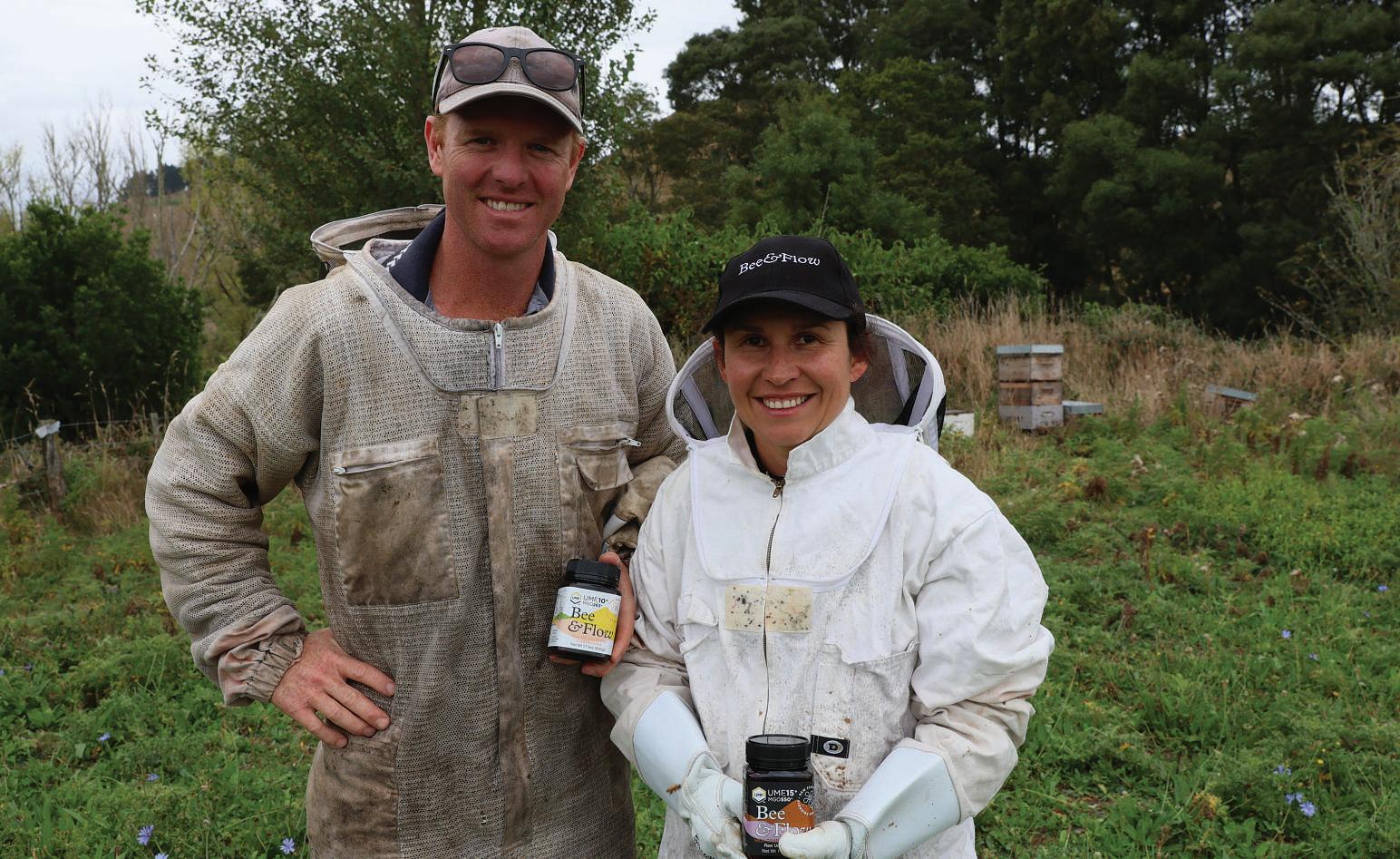
Catherine Groenestein
Honey has eclipsed hockey in the life of a former Black Sticks player who now runs the family farm with his wife in eastern Taranaki.
Ben and Julie Collier run a thriving mānuka honey business, Bee&Flow, as part of their farming operation at Mangamingi, inland from Eltham
The business began after Julia took up beekeeping as a new mum, and it grew alongside sons Cameron, 8, and Bruno, 6
Julia said she decided to learn about keeping bees when Cameron was still being breastfed, and completed a beekeeping course through Taratahi in Stratford
“I did it with a friend of mine, she was also breastfeeding her baby, and we shared the course work and being mums. It was beautiful; we just started with one hive.”
The course was “old school” and handson, including skills like making the wooden honey frames.
“I really grew to love working with the bees. That smell when you open the hive, it’s a beautiful animal.”
Catching their first swarm was an adventure, with Ben balanced in the tractor bucket, reaching up to catch the bees they’d spotted hanging off a tree.
She loves that their boys are growing up knowing where their food, including the honey they love, comes from.
“Knowing every step from the hive and the bees, it’s good for the kids.”
The honey operation fits well alongside the farm’s sheep, beef and forestry.
“It works really well. Mānuka is good for erosion, bees are good in general, they’re a good animal to have in collaboration. And we love honey.”
The couple returned to the farm, which has been in the family for five generations, after Ben’s father Cam died 10 years ago.
Before then, they had been living in Auckland for five years, where he was working in finance and banking and she in marketing
Julia, who is from Mexico, and Ben met while they were both studying in the Netherlands
“I was studying and playing hockey,” Ben said.
“Julia was at the same school, we were a couple of shorties among the tall Dutch.”
During his Black Sticks career, Ben played 137 tests for New Zealand from 20052012, including at the 2006 Melbourne Commonwealth Games and 2008 Beijing Olympics, and narrowly missed selection for the 2012 London Olympic side.
“It was a great experience to see a bit of the world, be part of high-performance sport. I’m still involved with NZ indoor hockey,” he said.
He also plays in the Hāwera club competition on Friday nights to keep fit and recently attended a masters tournament in Northland.
Ben said the honey business made good use of areas on the farm where regenerating mānuka and erosion meant grazing sheep and cattle was challenging
“We have retired 60 hectares of some of
our more challenging country. Regenerating mānuka is an ongoing challenge, something we need to manage, but having the hives out there benefiting from the mānuka is good.”
The 2500ha farm, Mataimaroke (Valley of Matai), which has been in the family for five generations. It sits at the headwaters of the Tongahoe River and the shore of Lake Rotorangi.
The property has bush blocks which back onto Rotokare Reserve, and also 450ha of bush under QEII covenants.
The physical work with the hives was now carried out by Ben and a staff member, as Julia was kept busy with the marketing side of the business, which she fitted around her sport-loving sons’ activities.
She made a point of visiting the owners of the health food stores around the country that stock their honey.
“I like to get to know what they need and what their customers use the honey for.”
Each batch of their honey underwent extensive testing, using the MGO grading system, which verified it as genuine mānuka and its strength.
Mānuka honey has antibacterial and other health qualities and was often used for skincare, for healing wounds, and for gut health, she said.
The couple now have 100 hives placed on the farm.
Julia said a key part of ensuring great honey was their focus on the bees’ wellbeing.
They did not move the hives around the farm, and they left the bees enough honey to keep the hive fed through the winter,
rather than relying on sugar syrup.
“They live close to the bush, and for the majority of the year, there is food close,” she said.
In Taranaki, she sells the honey at the weekly farmers market in New Plymouth, online and at Down to Earth and the Health Shop, Centre City.
It was also finding a growing overseas market, including in the United States and Korea.
The couple were among eight Taranaki producers showing off their products at the Taste of Taranaki Pop-Up at Womad, which ran last month.
Bee&Flow honey was on show alongside Planta, Kahu Glen, Fire Down Below, Blue Petal, Fine Lime Co, Fundamentally Fungi, and MK Spice.
The popular foodie hotspot first appeared at Womad Aotearoa in 2024 and proved to be a recipe for success, with more than 40,000 festival-goers having the chance to taste test delicious creations, talk with producers and celebrate the region’s vibrant food and beverage scene.
The initiative by regional development agency Te Puna Umanga Venture Taranaki aimed to take advantage of the huge influx of visitors and showcase the strength of the region’s food and beverage industry.
General manager of investment Stacey Hitchcock said smaller high-value food and beverage producers were starting to play a larger role in the regional economy.
“We see huge potential for emerging food and beverage producers to progress from boutique operators to wide-scale distributors,” she said.
The chief executive of Horticulture New Zealand, Kate Scott, says the future of horticulture lies in the sector’s ability to embrace innovation and build capability.
It is now six months since I joined HortNZ as chief executive and it’s been really rewarding getting out and about meeting the passionate and resilient growers producing world-class fruit and vegetables while navigating a complex regulatory and economic landscape
In recent weeks, I have had the opportunity to engage with key industry groups, including New Zealand Kiwifruit Growers Incorporated at its forum in Mount Maunganui and the Dominion Federation of New Zealand Chinese Growers, where we acknowledged the significant contributions of Chinese growers to our industry.
The HortNZ team was also on the ground at Central Districts Field Days, engaging with growers and sharing insights on the future of horticulture.
Beyond New Zealand, I recently returned from Singapore, where I joined a country insights tour hosted by FoodHQ.
This was an opportunity to explore how other countries are adapting to land use change and diversity in food systems –reinforcing the urgency for New Zealand to take a proactive approach in shaping our own future.
The challenges for New Zealand growers are real, and the need for clear, practical policy settings has never been greater.
Without them, growers face unnecessary uncertainty at a time when food security and economic stability should be at the forefront of decision-making That’s why a key focus for HortNZ this year is ensuring our industry has a strong voice at the decision-making table.
Over the last few weeks we have been engaging with the Government on the urgent need for commercial vegetable growing to be recognised as a permitted activity – provided growers operate under freshwater farm plans that demonstrate sound environmental management.
The current system is unworkable, and without urgent action, growers will continue to face unnecessary barriers to food production.
We are also advocating for the national significance of fresh fruit and vegetables to be recognised in the Resource Management

Act (RMA) changes.
Beyond land and water use, our discussions with the Government have also focused on the critical importance of protecting highly productive land, improving water storage and allocation, and ensuring the right policy settings are in place to secure New Zealand’s ability to produce fresh, healthy food for both domestic and export markets.
The future of horticulture will be shaped by our ability to embrace innovation and build capability across the sector.
I recently had the opportunity to meet Dr Jack Bobo, an international expert on food and technology, during his tour with the Kiwifruit Breeding Centre.
Our discussions reinforced the importance of improving science communication and the evolving role of genetic technologies in food production
With the Government reviewing New Zealand’s science sector and the Gene Technology Bill progressing through Parliament, it is vital that horticulture remains at the forefront of innovation.
Investment in new breeding programmes, sustainable growing practices, and emerging technologies will be critical for the
“
Without a co-ordinated approach to water storage and allocation, the future of ... horticulture remains uncertain.
Kate Scott
industry’s long-term success.
Reliable access to water remains one of the biggest challenges for growers Without it, horticulture simply cannot grow It was encouraging to see Hawke’s Bay Regional Council take a proactive approach with its plans for a new water storage facility on the Heretaunga Plains – this kind of forward-thinking is essential if we want to build a resilient food production system.
HortNZ will continue to push for a national water strategy that balances sustainability with the needs of food producers. Without a co-ordinated approach to water storage and allocation, the future

of New Zealand horticulture remains uncertain.
Despite the challenges, there is much to celebrate. Horticulture remains a cornerstone of New Zealand’s economy, with export revenue projected to reach a record $8 billion by June 2025.
HortNZ remains committed to advocating for the policy settings, resources, and support that growers need to thrive.
As we continue these conversations with Government and industry, our focus is clear: ensuring New Zealand’s horticulture sector remains strong, sustainable, and competitive for generations to come.
Opinion
Kate Acland is the chairperson of Beef + Lamb New Zealand and a mid-Canterbury sheep, beef and dairy farmer.
Irecently spent three days on a study tour with our farm discussion group.
We were lucky enough to tour three spectacular properties, from the river flats of the Canterbury plains into the hills of the northern South Island
These were all properties of scale, run by highly skilled farmers with excellent stock performance All were careful custodians of stunning landscapes with an eye to the environment and a strong desire to see the next generation succeed But all three had come off one of the most challenging years in their farming careers. It’s been tough and in many places it’s been dry. Although there’s a positive feeling, the post-traumatic stress disorder as a result of the last year or so still lingers.
The chequebooks have been cracked open, but only very slightly and I don’t think we’ll see a rush to spend, instead it will be a focus on deferred maintenance, deferred fertiliser and principal repayments, where possible
All of the properties have looked to diversify their businesses, through a mix of carbon, dairy, tourism, retail, contracting and cropping – with varying degrees of ease and success.
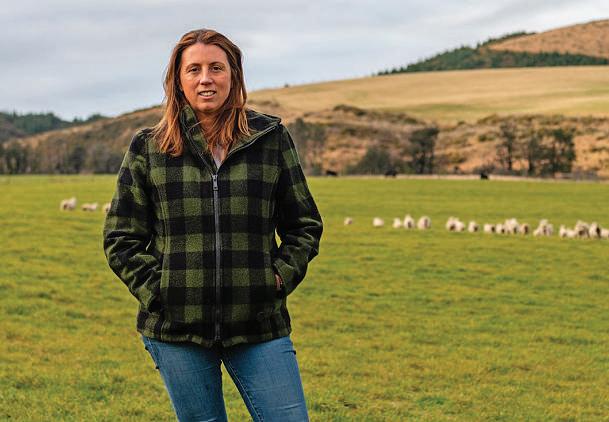
I’m a big fan of diversification and it’s something we’ve strongly pursued in our own business – again with varying degrees of success.
There’s two rules we live by, firstly be prepared to fail and to fail fast – if something isn’t working, cut the losses and stop. We’ve done it in our own business and we’d do it again in a heartbeat
Hopefully, it’s been a gentle testing of the waters without a lot of capital outlay, but stopping sooner when things aren’t going to plan almost always works out for the best.
Most importantly, the diversification can never threaten the core asset The farm is generally the engine room of the operation – any diversification can’t threaten this, either from capital requirements or time and attention
Beef + Lamb New Zealand chairperson
Kate Acland is a big believer in diversifying your business.
CLARE TOIA-BAILEY
Diversification is a fantastic tool and it did consume the lion’s share of the conversation throughout the study tour, however we shouldn’t assume there aren’t more gains to be made on the farm itself.
Last year, B+LNZ interviewed some leading farmers around future challenges for the sector. One of the most surprising insights was the perception that there weren’t any more productivity or profitability gains still left to be achieved as most of it had been done.
We’ve talked so much about constraints in the last couple of years – water, nutrients and climate reductions etc, that many of us have got into a mindset of not chasing productivity gains.
We may feel like we’ve made the easy productivity gains, but there’s absolutely more we can do while still being good custodians of the land. What the study
tour highlighted for me was that we should continue to focus on this.
Genetic improvements to further lift lambing percentages, improving feed conversion efficiency and animal health and growth rates will grow the bottom line as well as improving our climate metrics.
Beef has even greater potential gains than our sheep industry, with relatively fewer advances in the past two decades.
There is also room to improve our national calving performance, weaning weights and growth rates.
Ongoing genetic improvement and selection of high-performance sires, as well as better use of quality beef genetics across our dairy herd for better beefon-dairy progeny, will improve our performance across the sector.
Improved pasture and supplementary fodder crop options that are suited for a changing climate will all further help improve our farm productivity and resilience.
The largest area of levy investment by B+LNZ is in the science, genetics and research space, closely followed by education and extension.
B+LNZ’s Informing New Zealand Beef programme and the new nProve is just one of the tools we’re providing, putting genetics insights into the hands of farmers, which will be a major boost for farm performance.
We’re committed to finding opportunities for ongoing improvement in our sector.
Diversification where it makes sense is a great strategy – but we must never forget the farm is the driving force of most of our businesses and we need to make sure it stays that way.
Low lamb supply coupled with higher demand has helped exporters create market tensions, Silver Fern Farms chief executive Dan Boulton says
“Last year was another challenging one for the red meat industry, but 2025 has started on a more positive note,” he said
The Meat Industry Association has reported red meat export values increasing 28% year-on-year in January to $927 million while Agriculture Minister Todd McClay is expecting beef and farmers to earn an extra $1.2 billion this year.
Boulton said improved livestock flows in 2024 was helping distribute margins more evenly across the supply chain.
“While market pricing improved in the second half of 2024, that coincided with lower livestock volumes, which saw some heightened procurement tension playing out,” he said.
Beef pricing was strong, but farmgate pricing for lamb had also been performing well, “particularly this far into the season”, Boulton said.
“We have seen a lift in demand for lamb and we’ve been able to use the lack of supply to leverage some tension into pricing in our markets.”
Lower South Island lamb volumes were back on the same time last season, but some of this was deferred processing with farmers holding animals back on farm, Boulton said. With a couple of short weeks ahead

“While market pricing improved in the second half of 2024, that coincided with lower livestock volumes, which saw some heightened procurement tension playing out.”
Dan Boulton, above Silver Fern Farms chief executive
over Anzac Day and Easter, he encouraged farmers to reach out to their livestock representative early. Alliance Group global sales director James McWilliam said the group was seeing

“While China remains a key market for Alliance, we are actively focusing on the strongest global opportunities to maximise value for our farmers.”
James McWilliam, above Alliance Group global sales director
positive momentum in most of its markets with supply shortages increasing prices. “In North America, lamb prices remain strong across all cuts in both retail and food service sectors,” he said, while the UK
market was experiencing solid growth in lamb sales and demand was increasing in the European Union.
“In the US, beef prices continue to rise, though the rate of increase has slowed, with prices now significantly above the five-year average,” McWilliam said.
The group was monitoring the potential impact of any shifts in US trade policy, he said. China’s market continued to face significant challenges off the back of ongoing economic pressures, McWilliam said and its recovery is expected to lag behind other global markets.
“While China remains a key market for Alliance, we are actively focusing on the strongest global opportunities to maximise value for our farmers.”
Meat Industry Association chief executive Sirma Karapeeva said the growth in export values reflected “both the ongoing recovery in global demand and the ability of New Zealand’s red meat sector to adapt to shifting market dynamics”.
McClay said the sector growth was “extremely positive news for sheep and beef farmers who have been doing it tough over the last six years”.
“New Zealand’s trade is extremely diversified with our network of free trade agreements offering exporters choices about where they send their products,” he said.
“For example, the newly enacted trade agreement with the European Union has seen goods exports to Europe increase by more than 24% over the last year with sheep meat playing a big part in this growth.”
The Government would continue backing sheep and beef farmers by reducing red tape and compliance costs, McClay said.
Alka Prasad
Tariffs threaten to upset a surge in demand in the United States for lean New Zealand beef, especially for use in burgers where the discerning consumer is after the ‘grass fed’ experience.
Meat Industry Association data shows beef and sheepmeat exports in January 2025 were up almost 30% on the year prior, to $927 million, with the US nudging ahead of China and accounting for $277m in exports, just ahead of China at $276m.
That was a 64% growth for New Zealand red meat to the US between last January and this January. Beef to the US on its own rose 24%, with value up 73% to $194 million.
MIA chief executive Sirma Karapeeva said New Zealand lean beef is blended with US beef in American burger patties because US beef is considered too fatty on its own for burgers. There are also fewer cows in the US, with the beef herd down 1% in the 12 months to January 2025.
The integral part New Zealand plays in the iconic American meal made New Zealand a “complementary trading partner” with the US, Karapeeva said.
New Zealand’s high value lamb products to the US were also popular, although they declined in value and volume in the year, the data said. Red meat exports to China rose 10% in value, earning this country $276m, but volumes to the country dropped 14%.
Beef demand was up 6% globally with volume up 38,788 tonnes and revenue up 36% to $409 million, despite softness in the China market. Red meat export receipts are forecast to rise 13% to $10.2 billion at the 2024-25 full-year mark over the previous season, despite lower overall export volumes, MIA data showed.
Last month, Minister of Agriculture


Todd McClay said the revenue boost would be “extremely positive news for sheep and beef farmers who have been doing it tough over the last six years”.
Sheepmeat demand Beef and Lamb (B+LNZ) agreed the current financial year would see prices and profitability rebound, with overall value to increase by $1.2 billion on last year to reach $10.2b in the year, despite lower overall export volumes.
Chairperson Kate Acland said strong demand and commodity prices were a relief for the sector, which had been battered by economic headwinds and surging production costs.
A mid-season update from B+LNZ showed that while demand for red meat





remained positive, Chinese demand had dropped and significant risks on the horizon remained as a result of US trade policy and subsequent global supply chain disruptions.
An increase in pricing being enjoyed by New Zealand farmers this year was in part the result of lower herd levels.
All New Zealand’s beef and sheep herds were down in numbers, and in sheepmeat, low supply in New Zealand and the EU/UK was supporting the better pricing. Export revenue from sheep was up 22% to $359m in the last year, even as volumes were flat at 35,220 tonnes, with strong demand in China.
In beef, Australian and Brazilian supply was likely to be strong in the current year but North American demand would offset any price decreases. But the critical US market was again singled out for geopolitical vulnerability. Acland said geopolitical risks were “on the horizon” with ongoing tit-for-tat tariffs hitting global export demand. “We are keeping a very close eye on US trade policy developments which have the potential to create global market volatility,” she said.
Farmer confidence low but recovering Costs remained a concern despite the lift in profitability, the B+LNZ chairperson said, with the ongoing threat of severe weather events also ever-present.
“Farmer confidence is slowly recovering, but regulatory uncertainty around climate change, freshwater and other policy issues continue to weigh heavily on their minds,” she said
Acland said farm profitability was set to improve as a result with forecast farm income projected to be at $106,500, nearly double last season’s $56,400, but still below the five-year average.
“While revenue has improved, farm input costs have risen 33% over the past four years, meaning profitability is still below long-term sustainable levels,” Acland said
“We are seeing positive signs for the sector, but uncertainty remains.”

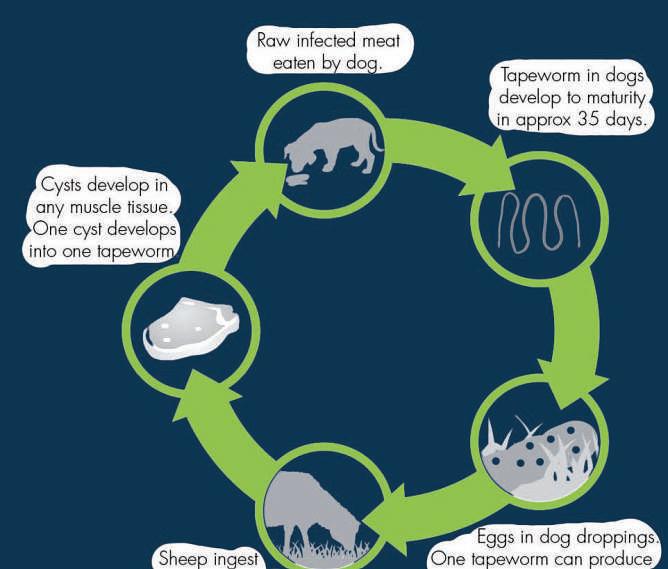
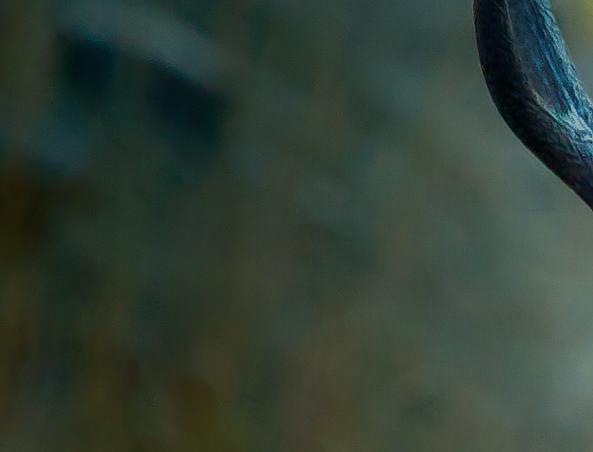
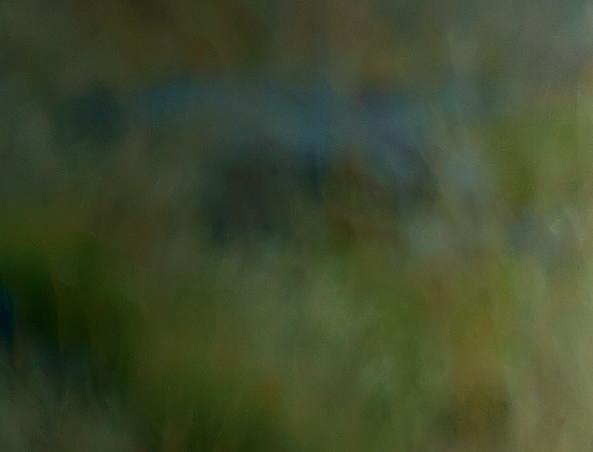

Identify yourtarget beyond all doubt. Whetheryou’re using optical or thermal imaging devices, if in doubt,don’t shoot!


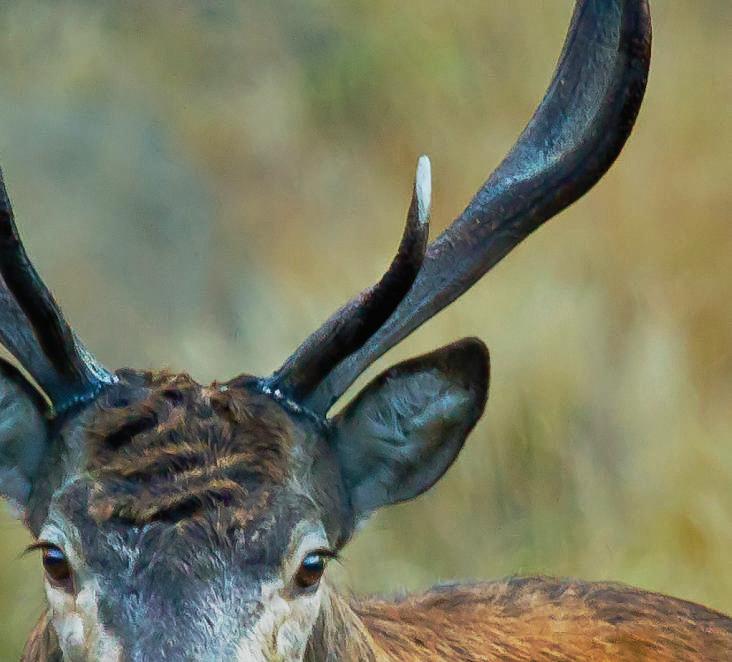


The global log and timber market has always been subject to cycles of boom and bust, but recent years have brought unprecedented volatility driven by economic uncertainty, shifting trade patterns, and environmental pressures, says Scott Downs, director of sales and marketing for PF Olsen.
For New Zealand – one of the world’s largest exporters of softwood logs, particularly Pinus radiata – these fluctuations have had a profound impact on profitability, workforce stability, and long-term strategic decisions
Dependence on export markets
New Zealand exports around 60% of its harvested logs, with China being the dominant market, taking nearly 90% of New Zealand’s log exports. This heavy reliance on one market makes the industry particularly vulnerable to shifts in Chinese demand A cooling property market in China has led to reduced construction activity, which in turn has softened demand for imported logs and timber. This reliance on China exposes New

Zealand exporters to the risk of singlemarket dependency. When Chinese demand contracts, there are limited alternative markets that can absorb New Zealand’s surplus supply at comparable prices.
The reopening of the Indian market in September 2023, following an interim agreement that allows for log fumigation upon arrival, has provided some relief. However, the primary use for New Zealand logs in India pallets and packaging for export products makes this market sensitive to broader global trade disruptions, limiting its long-term stability as a strategic alternative.
Shifting market dynamics
Historically, financial returns from forest harvesting in New Zealand was often counter cyclical to global economic
downturns. When the global economy slowed, reduced demand for shipping lowered freight costs, improving margins for New Zealand log exports.
Strong Chinese demand, driven by government stimulus and a real estate boom, maintained high log prices despite global slowdowns. This created a favourable environment where financial returns increased due to lower costs and strong demand.
That dynamic has now shifted. China’s economic slowdown, rising trade tensions, and global supply chain disruptions have created a more complex and less predictable operating environment for New Zealand forestry.
Shipping costs and supply chain disruptions Global supply chain disruptions
particularly following the COVID-19 pandemic have added to market instability. Shipping costs have been highly unpredictable, influenced by:
■ Rising fuel prices
■ Port congestion and container shortages
– when container rates spike, some container-based goods shift to break bulk shipping, driving up bulk freight costs.
■ Geopolitical tensions – conflicts affecting key shipping routes have increased both costs and uncertainty.
Higher freight costs directly affect the profitability of log exports, especially when global log prices are under pressure from weakened demand.
Looking ahead
Market volatility is likely to persist, but New Zealand’s forestry sector has opportunities to strengthen its position by:
■ Building greater resilience through diversified markets and domestic processing capacity.
■ Developing innovative timber products for high-demand markets such as construction and renewable energy
■ Enhancing supply chain efficiency and reducing freight costs through infrastructure investment.
Despite near-term challenges, the longterm outlook for New Zealand’s forestry sector remains positive. Growing global demand for sustainable building materials and carbon sequestration presents a significant opportunity. By expanding domestic processing capacity, diversifying markets, and improving supply chain resilience, New Zealand can position its forestry sector to thrive in an increasingly complex global market.

The new chief executive of Safer Farms, Brett Barnham, reflects on the first three months of his role.
I’m now almost three months into my role as chief executive officer of Safer Farms and I’ve been on the road meeting farmers, listening to their concerns and seeing first-hand the incredible work happening across New Zealand’s rural sector
Farming is more than just an industry –it’s a way of life for thousands of Kiwis, built on hard work, resilience and community.
But it’s also a sector where health and safety remain real challenges that we must tackle together.
One thing is clear: no farmer wants to see their family, workers or neighbours hurt.
Yet, we are still seeing too many serious injuries and fatalities in our sector. The reality is, every number in the statistics represents someone’s mate, someone’s parent, someone’s child.
For me, this isn’t just about compliance or ticking boxes – it’s about ensuring that everyone who heads out in the morning comes home safely at night.
The conversations I’ve had over the past two months have reinforced the importance of a practical, farmer-led approach to safety.
Farmers don’t need more rules handed down from above. What they need are workable solutions that fit the realities of

farming life – tools, training and support that help them make the right decisions in the moment.
One of the biggest challenges we face is shifting the perception of safety from being a burden to being a benefit.
The farmers I talk to tell me safer farms are more productive farms.
When we take care of ourselves and our people, we reduce downtime, increase efficiency and strengthen our businesses.
Good health and safety practices are not just about avoiding accidents – they’re about creating a culture where people care about each other, feel valued, supported
and able to perform at their best. One of the key messages I want to share is that safety doesn’t have to be complicated.
Small, everyday decisions – like wearing a helmet, taking a moment to plan a job, or speaking up when something doesn’t feel right – can be the difference between a close call and a tragedy.
We need to encourage a mindset where farmers feel comfortable looking out for each other, not because they have to, but because they care.
We also need to recognise that mental health is a crucial part of farm safety.
Stress, fatigue and isolation can all


“
We’re here to support, listen and ensure that safety is seen as an enabler for your farm business, not a barrier.
contribute to poor decision-making and increased risk.
Reaching out for support – whether it’s to a mate, a neighbour, or a professional –can be hard, but it’s a sign of strength, not weakness.
At Safer Farms, we are committed to working alongside farmers to develop practical, industry-led solutions that work in the real world.
We’re not here to lecture or dictate.
We’re here to support, listen and ensure that safety is seen as an enabler for your farm business, not a barrier.
Over the coming months, you’ll be hearing more from us and our partners.
In the meantime, I encourage every farmer to take a moment to reflect on what safety means for them, their family and their business.
For me, safety should be second nature, not an afterthought.
Because at the end of the day, the most valuable thing on any farm isn’t the land, the stock, or the tractor – it’s the people who make it all happen.





The team at Peninsula speak with Matteo Jones, head of health & safety, Peninsula New Zealand, to learn more about being prepared for the wetter months.
Farming in New Zealand is a yearround commitment, but the wet season brings unique challenges that demand extra attention to health and safety Heavy rainfall, muddy tracks, flooding, and unstable terrain all increase the risk of accidents, injuries, and damage to property. Preparing for these conditions is essential to keep workers, livestock, and equipment safe.
What are the key risks during the wet season?
Slips, trips, and falls are some of the most common hazards when working in wet conditions. Rain-soaked ground, waterlogged paddocks, and slippery surfaces make it easy to lose footing, increasing the risk of sprains, fractures, or worse Machinery, such as tractors and ATVs can

be harder to control on muddy ground, leading to rollover accidents or mechanical failures. Livestock handling also becomes more challenging. Animals can be more unpredictable in wet weather and moving them through flooded or slippery areas can be dangerous for both humans and animals. Flooding presents another major concern. When fields and farm tracks become waterlogged, access to different areas of the farm can be restricted, while stagnant water can damage infrastructure, contaminate water supplies, and increase the spread of disease.
What can farmers do to improve health and safety?
Wearthe right gear
Investing in footwear to suit conditions helps maintain stability when navigating wet and muddy terrain. Waterproof clothing is also essential to keep workers warm and dry, preventing illness and fatigue.
Check and maintain equipment
Wet conditions can accelerate corrosion and mechanical failures in farm machinery. Regular maintenance checks are essential to ensure brakes, tyres, and hydraulic systems are in good working order.Vehicles should be fitted with appropriate tyres for wet conditions to improve traction and
Left:Thewetseason bringsunique challengesthatdemand extraattentiontohealth andsafetyonfarms. Below:MatteoJones, headofhealth&safety, PeninsulaNewZealand, saysthereareplentyof thingsfarmerscandoto prepareforthewetter months
reduce the risk of skidding.
Improve drainage and flood preparedness
Assessing farm infrastructure before the wet season can help prevent costly damage. Clearing drains, reinforcing culverts, and ensuring paddocks have adequate runoff channels can reduce the impact of heavy rainfall. Farmers should also have a flood response plan in place, including access to emergency contacts, alternative access routes, and secure storage for equipment and supplies.
Safe livestock handling
more prone to slips, orvehicle incidents
Why is training important?
Health and safety training should be a priority heading into the wet season. Workers need to be aware of the specific risks associated with wet weather and be equipped with the skills to manage them. Topics should include: safe machinery operation on wet terrain, emergency procedures in case of flooding or severe weather, correct lifting and handling techniques to prevent injuries and recognising and reporting hazards like unstable ground or damaged infrastructure.

Mental health matters too
Long periods of wet weather can put financial and emotional strain on farmers Particularly when operations slow down, or unexpected repairs are needed. Isolation, stress, and fatigue can take a toll, making it important for farmers to check in on their own wellbeing and that of their workers. Encouraging open conversations, seeking support, and taking regular breaks can help prevent burnout during challenging seasons
Meeting legal obligations
Ensuring that pens, loading areas, and pathways are maintained and free of excessive mud will make handling livestock safer. If possible, animals should be moved in dry conditions to avoid injuries caused by slipping. Using appropriate gates, fences, and handling equipment can help minimise risks.
Farm maps
Ensure workers are aware of the changing environment and areas on the property that may be affected by the wet weather. Your risk management should take into account the steep terrain because wet surfaces are
New Zealand’s Health and Safety at Work Act 2015 requires farm owners and operators to take all reasonably practicable steps to ensure worker safety. This includes identifying hazards, providing training, and maintaining safe working conditions Failing to comply with health and safety regulations can result in serious consequences, including fines and legal action, but more importantly, it puts people at risk.
Be prepared, stay safe
The wet season may bring uncertainty, but with the right preparation, farmers can minimise risks and keep their operations running smoothly.









Windstar’s next Tahiti cruise on Star Breeze departs from Papeete in November 2025. The 11-day round trip starts from $7463. See: windstarcruises.com
Getting there: Fly to Papeete from Auckland with Air Tahiti Nui or Air New Zealand
See: nz.airtahitinui.com; airnewzealand.co.nz
Be mindful that you might need an overnight stay before or after your cruise due to flight arrival times.







Exploring the island delights of French Polynesia with Windstar delivers in many surprising ways, writes Helen Hayes.
Boarding Windstar’s Star Breeze in Tahiti, my mind is filled with visions of snorkelling alongside velvety stingrays in Bora Bora’s turquoise lagoons, swimming with myriad finned friends in pristine coral gardens and soaking up the heavenly scent of vanilla wafting on the breeze from dreamy atolls.

But as nature would have it, the dream became something else entirely, in a far more mysterious location.
After setting off from Papeete on the inaugural sailing of Star Breeze in her new home, the stirring Conquest of Paradise byVangelis playing, we frolic in Fakarava before our itinerary goes out the porthole.
Thanks to a cyclone growling in our path, the captain and his crew wave their magic wands and organise a detour, and a rather large one at that, to the Marquesas Islands
Called Fenua Inata by the locals, the Marquesas are the most remote archipelago on the planet.
Somehow, the captain and crew managed to get permission for us to visit some of the islands, organised tours for us to do – impressive when you think they haven’t been before – and even organised some cultural displays. All in 24 hours. Not run-of-the-mill displays either, but experiences of the unforgettable variety.
On Nuku Hiva, we explored in a snaking line of 4WDs venturing up hill and down dale, through riotous vegetation, wild horses and roaming

chickens – who “belong to everyone and no-one’’.
Locals gather to perform the traditional haka manu – bird dance – which we watch with a backdrop of our ship and a vivid sunset. On Hiva Oa, we pay our respects to French artist Paul Gauguin and Belgian singer Jacques Brel, both of whom are buried on the island after making their homes here.
We tour an archaeological site that is only partlyvisible thanks to a determined jungle trying to keep its secrets, and witness a traditional Marquesan wedding ceremony, put on for a couple of lovebirds from the ship by the mayor.

for

Balcony Suite and it impresses with plentiful storage, lounge area, desk and small veranda Days start early with a coffee at the Yacht Club, or out on the deck to watch the sun rise over the sea. Breakfast is at the Star Grill or the Verandah, which turns into Candles for dinner at night. The bow’s hot tub is perfect for sunset, and for dinner, Candles, Cuadro 44 and Amphora provide a tastyvariety no matter your tastes.



Think grass-skirt-clad warriors, women swirling elegantly, and a ‘bride’ and ‘groom’ in full Marquesan regalia smiling broadly among the throng. It was really special.
Windstar has been sailing in French Polynesian waters for 37 years. Locals love the ships and the feeling is reciprocated. Windstar was the first to hire French Polynesians – something that required a change of law – and I chatted to several locals in various roles on the ship.
You can taste traditional dishes, do some craft and learn to play the ukulele under the tutelage of the beautiful Pearl, whose smile lights up the deck.
Star Breeze is an all-suite ship hosting up to 312 guests. In no time flat the incredible crew know my name, what I drink and how I like my coffee. They feel like family, which is a big reason the retention rate for crew is so high, and also for guests, who come back again and again.
Life on board is exquisite. I love my
The spa on board is excellent, there is a gym, a central pool and hot tub, and the ship’s Marina is excellent. It’s a cleverly designed watersports platform that gives direct access to the turquoise water when anchored and when conditions allow. When open, you can take out a kayak or SUP, jump on the floating trampoline, or swim.
Everything about this experience is exquisite, from the mystery of what we were doing and where we were going – something that actually spawned an official Mystery Cruise that is happening in April in and out of Athens – to the beauty of the islands, the shipboard guests who all became friends through our shared adventure, and last, but definitely not least, the warm hearts of the crew.
They make Windstar.
Last month’s travel story, NZ’s newest luxury alpine escape, suggested guests were fishing for salmon. However, fishing for salmon in Winding Stream is not permitted at any time.










